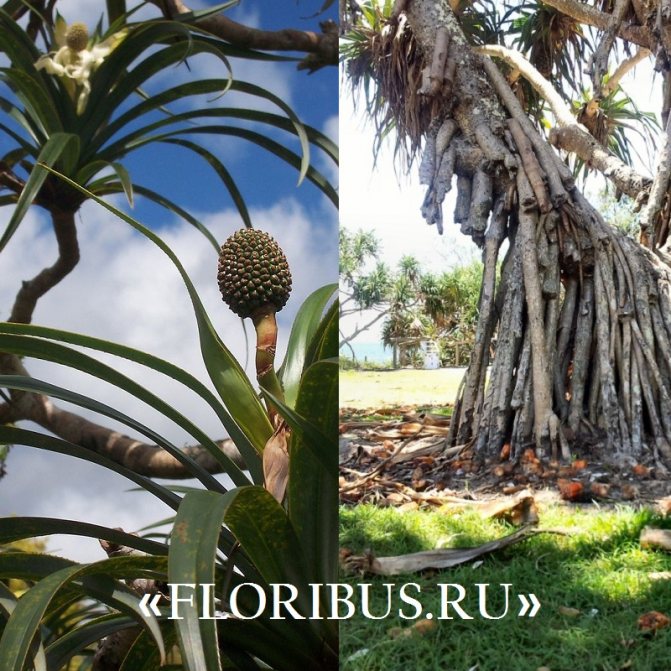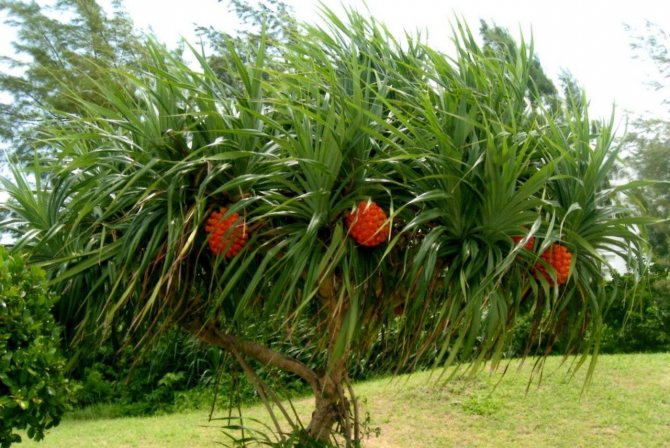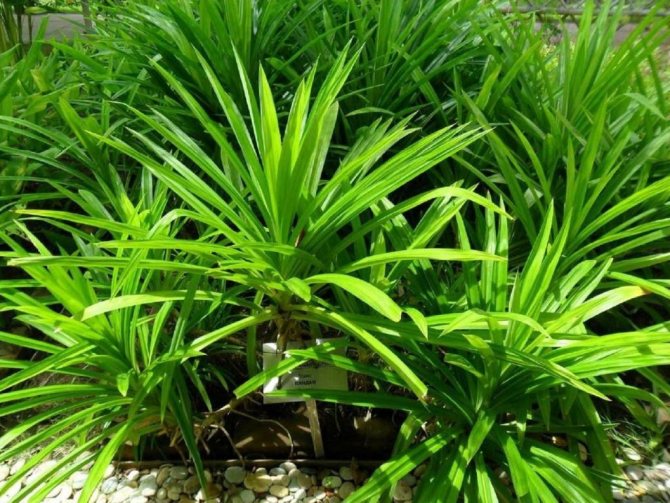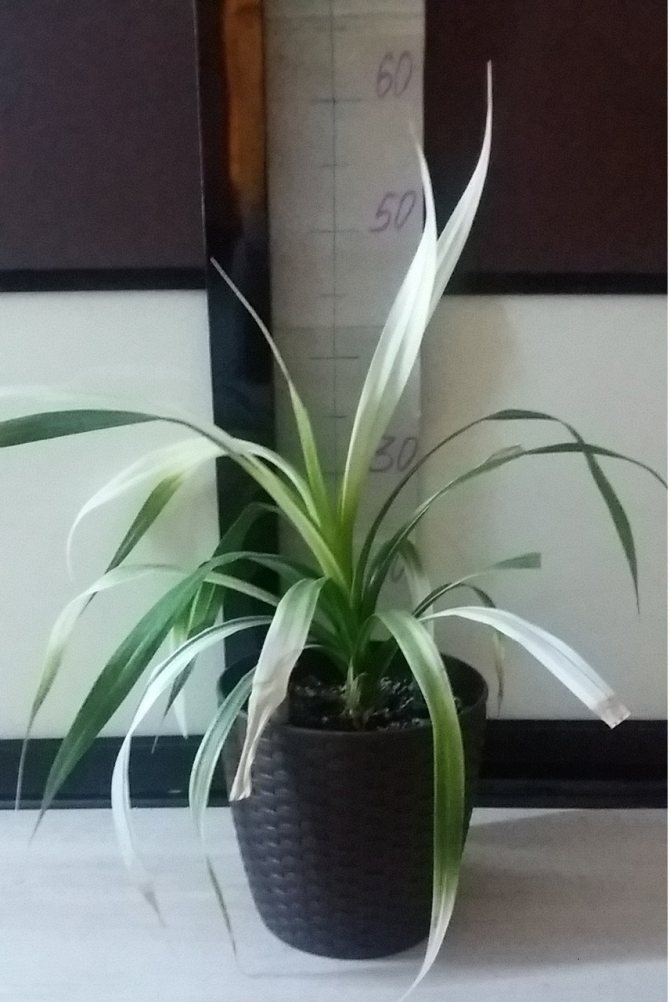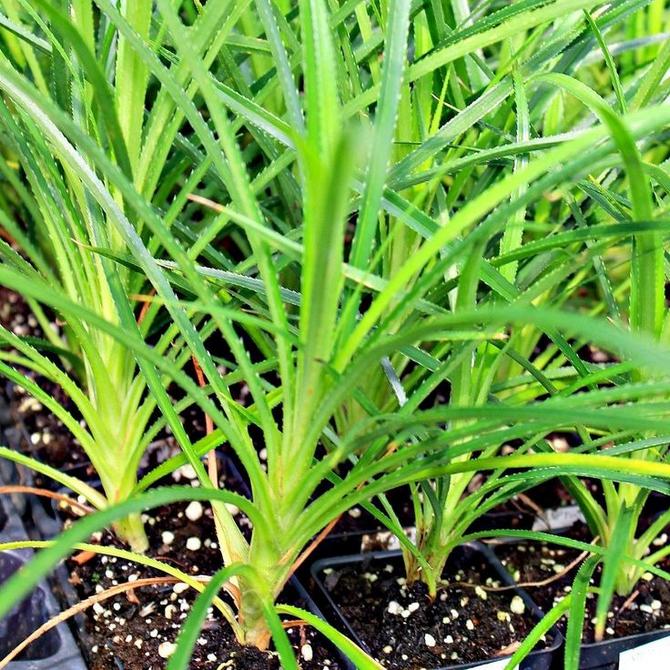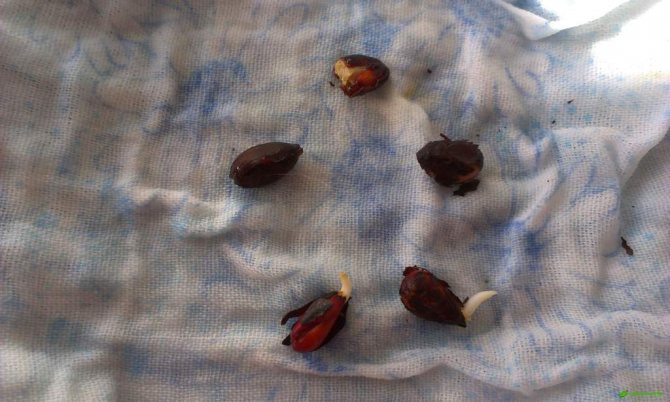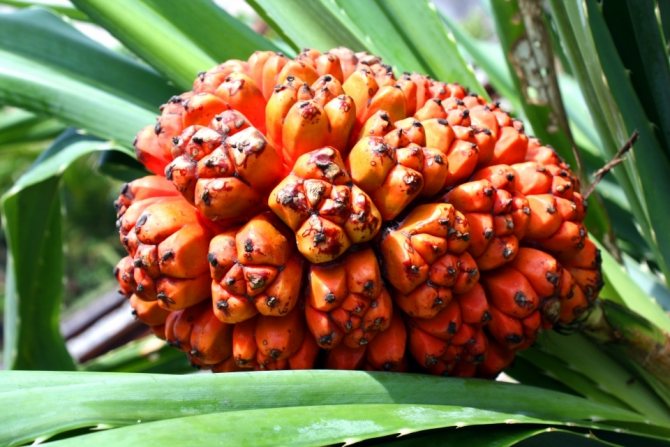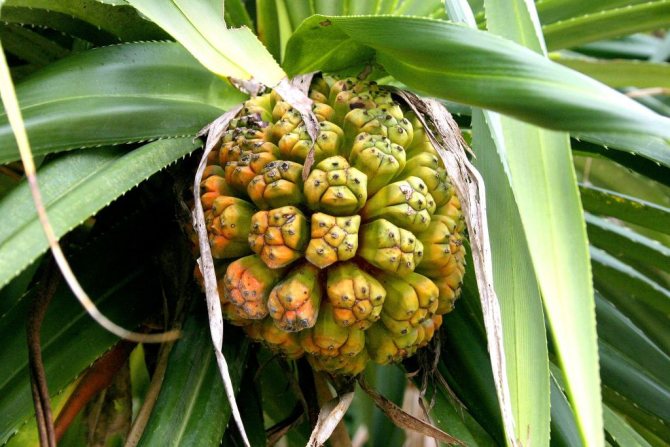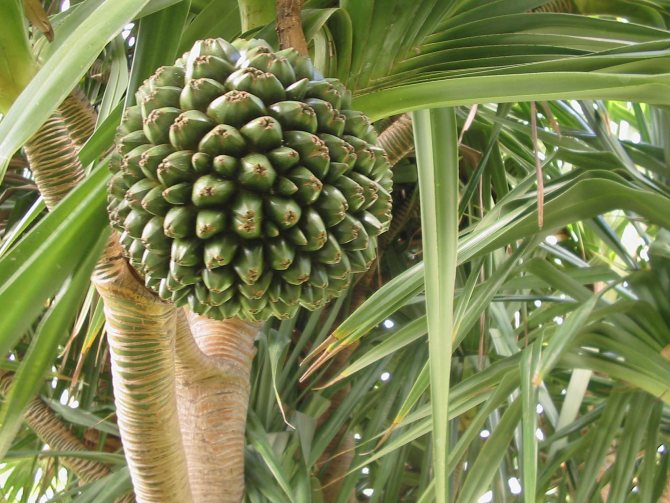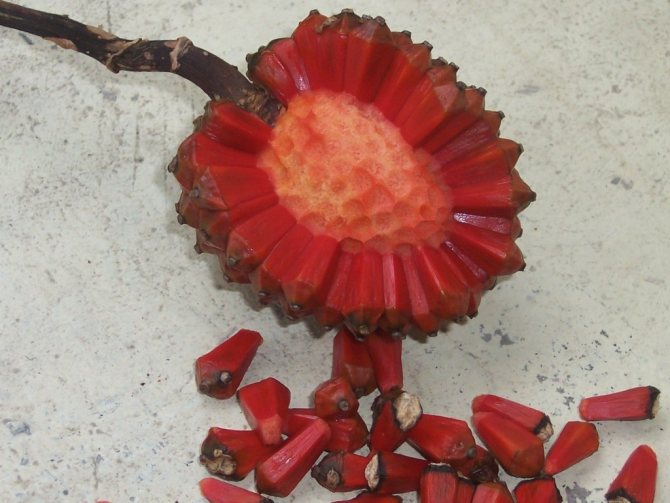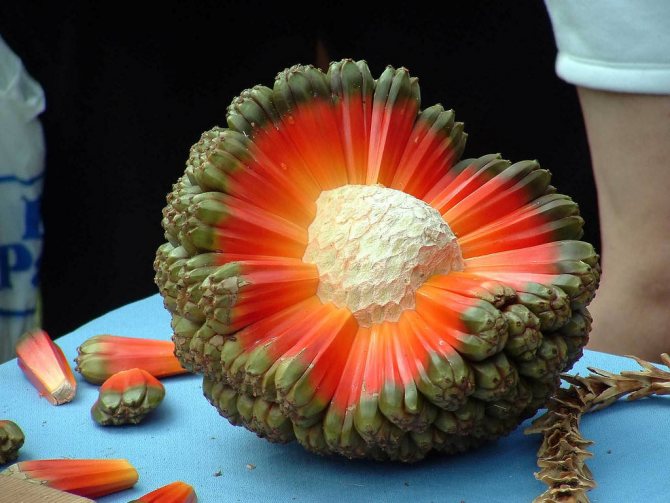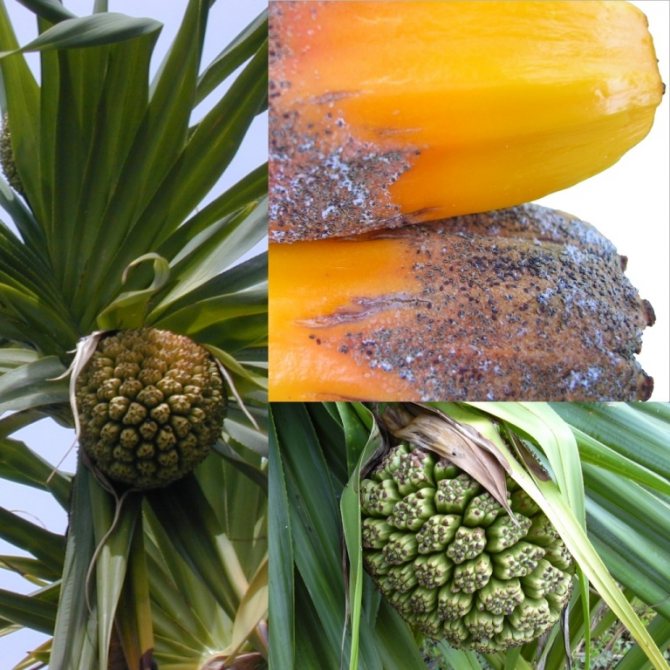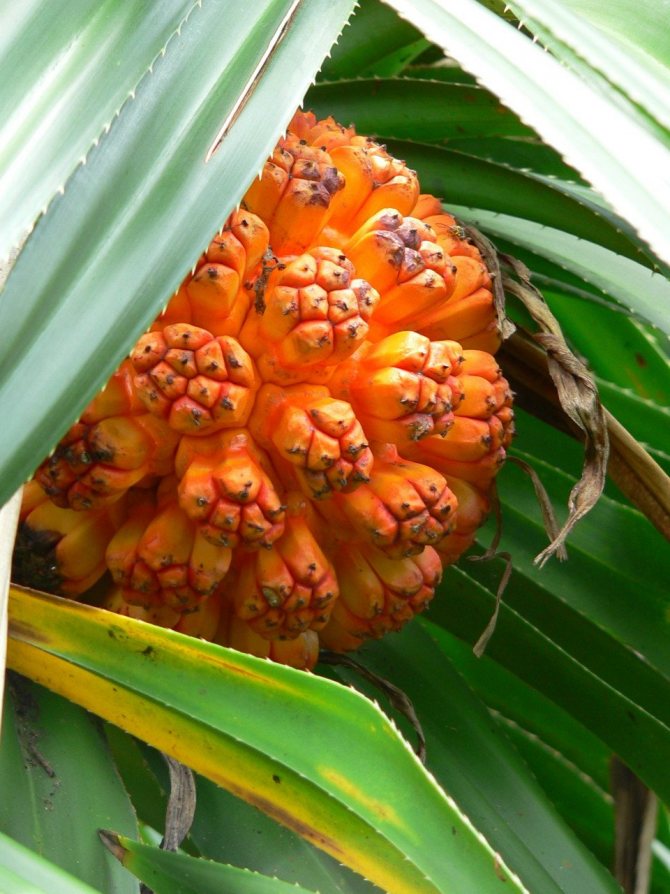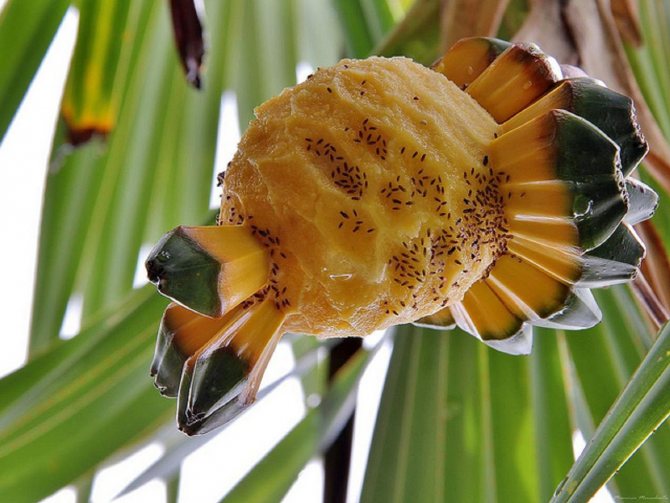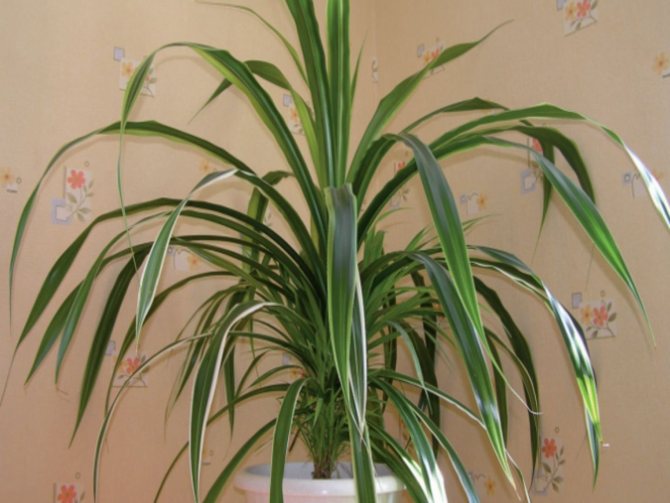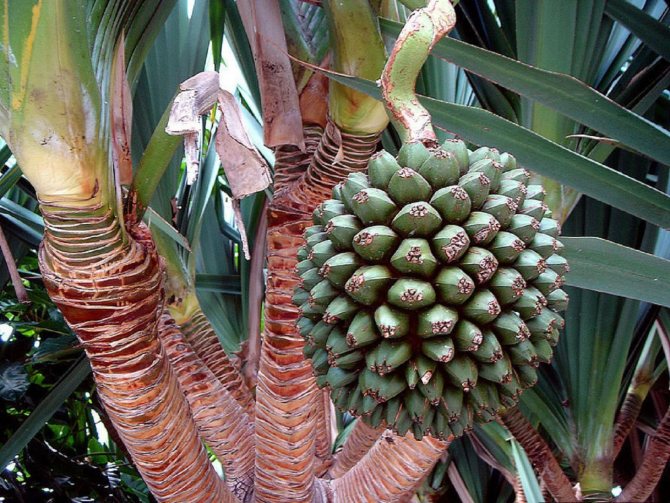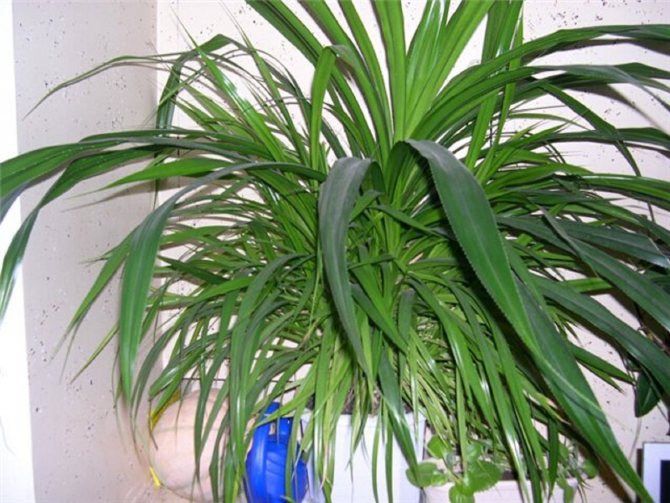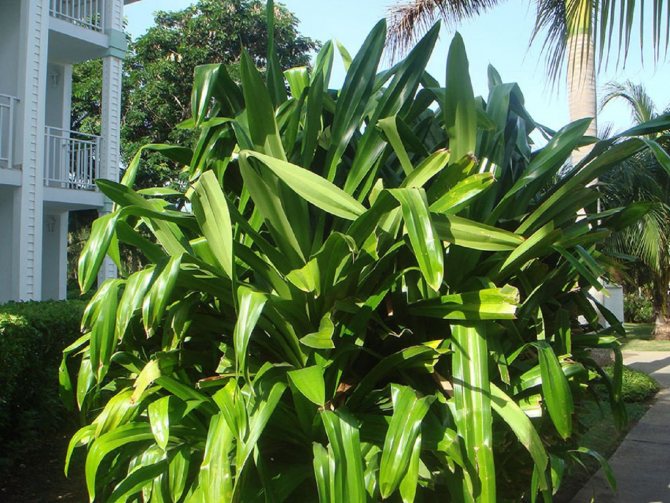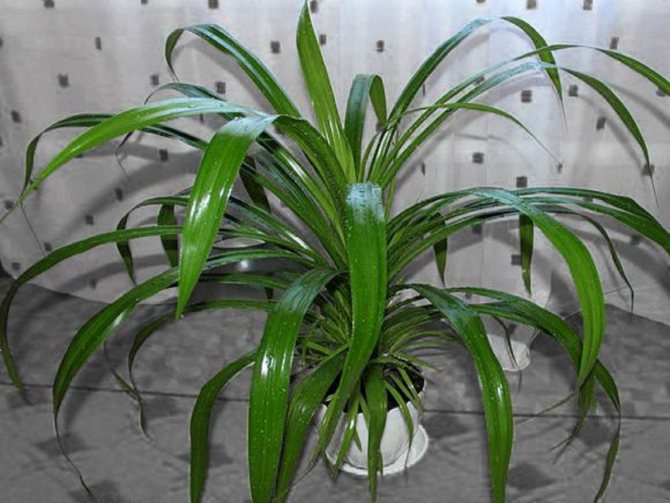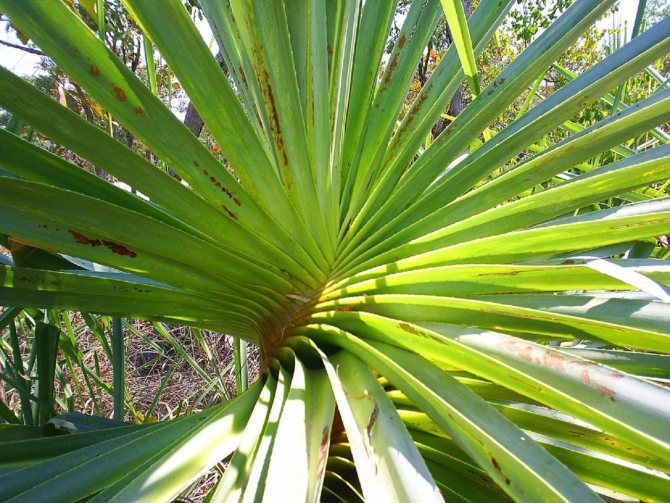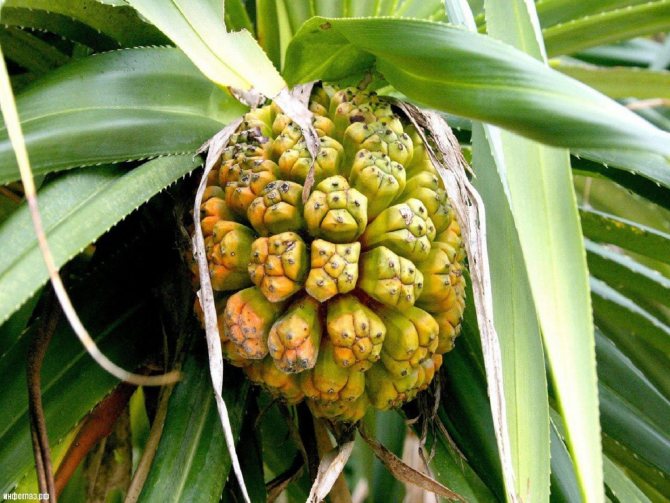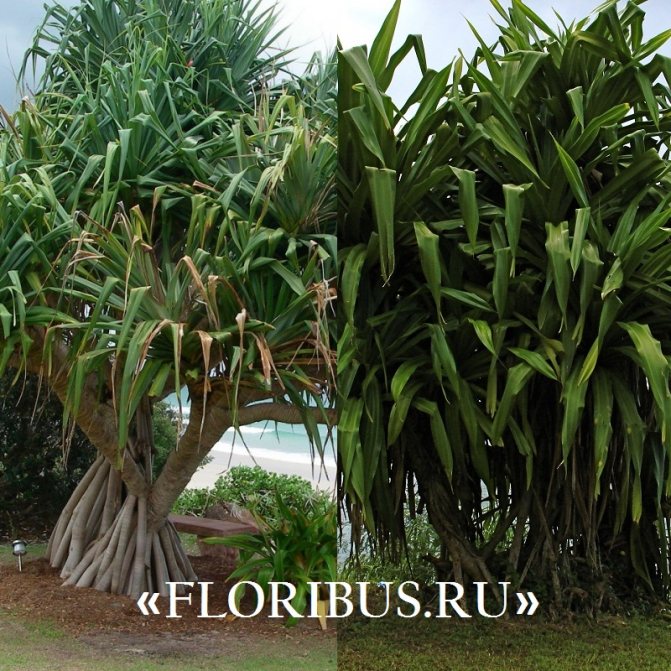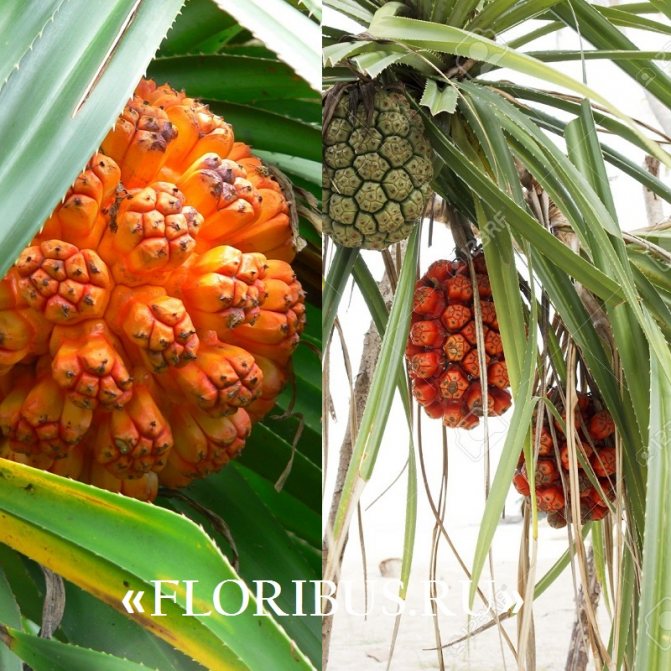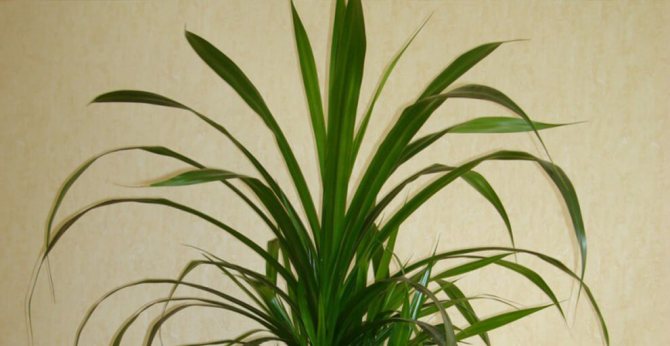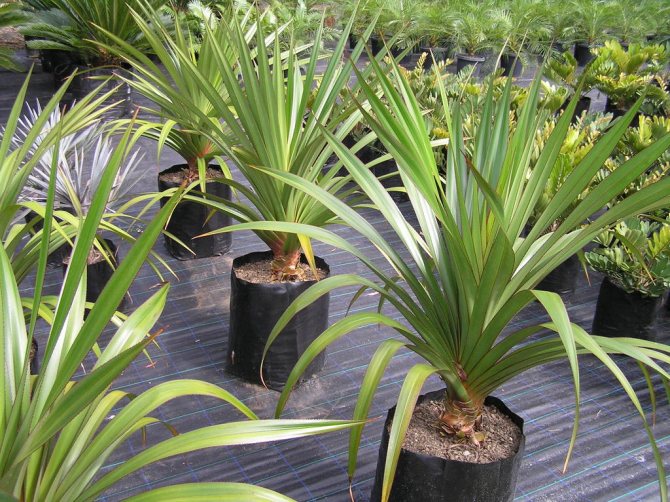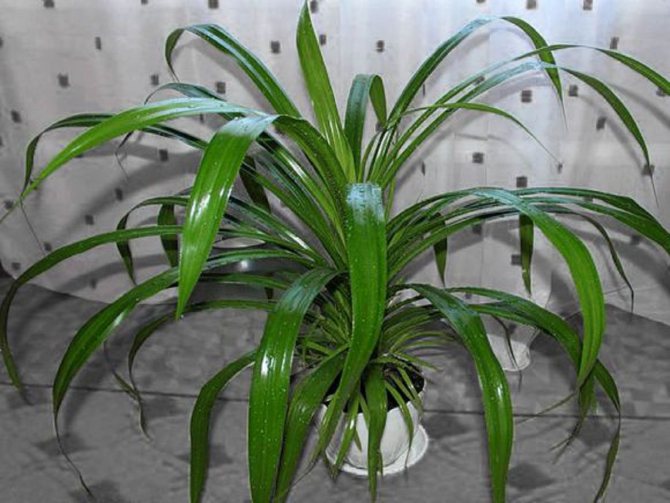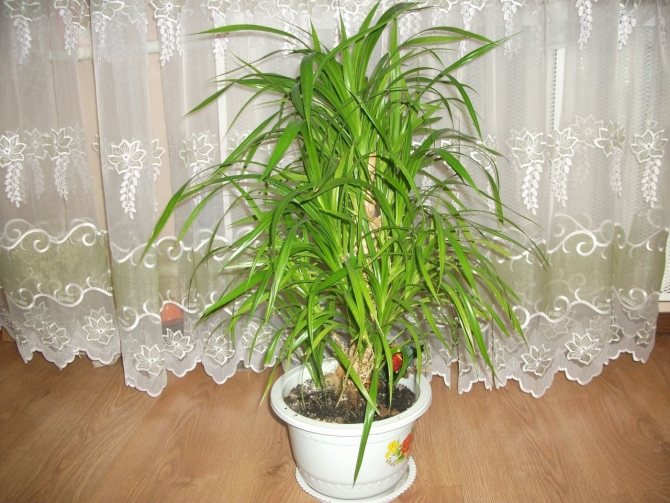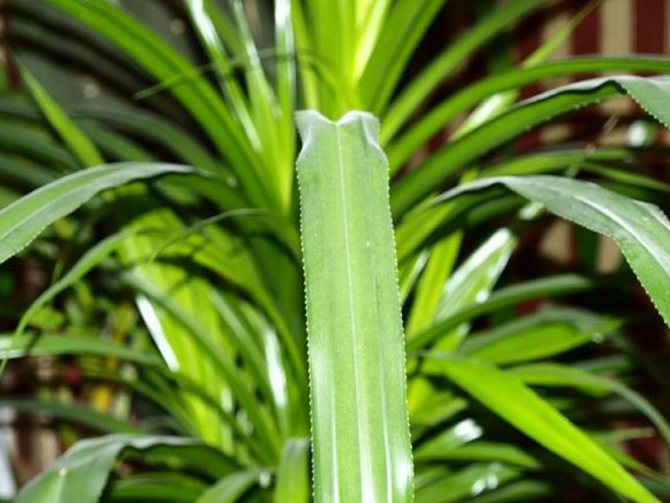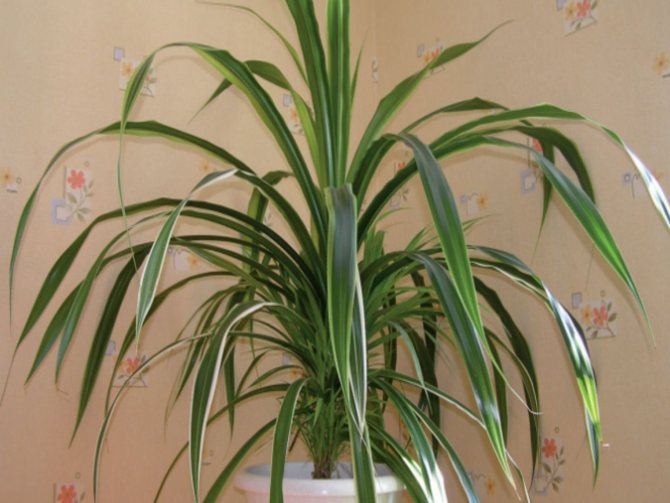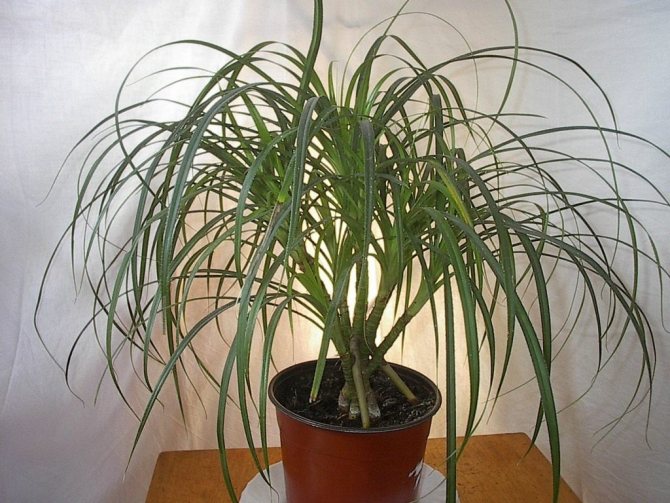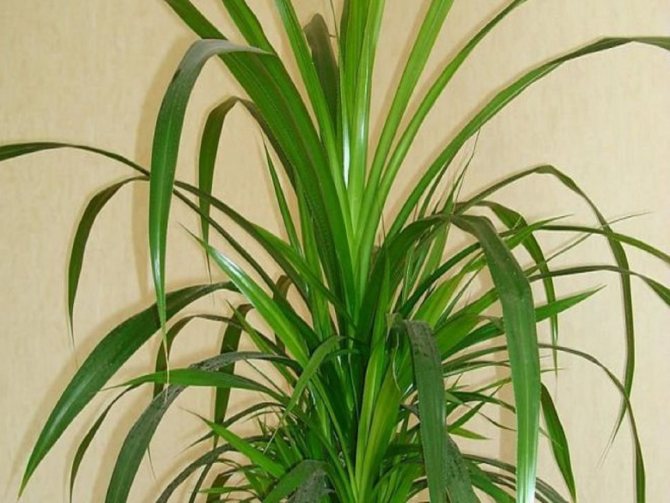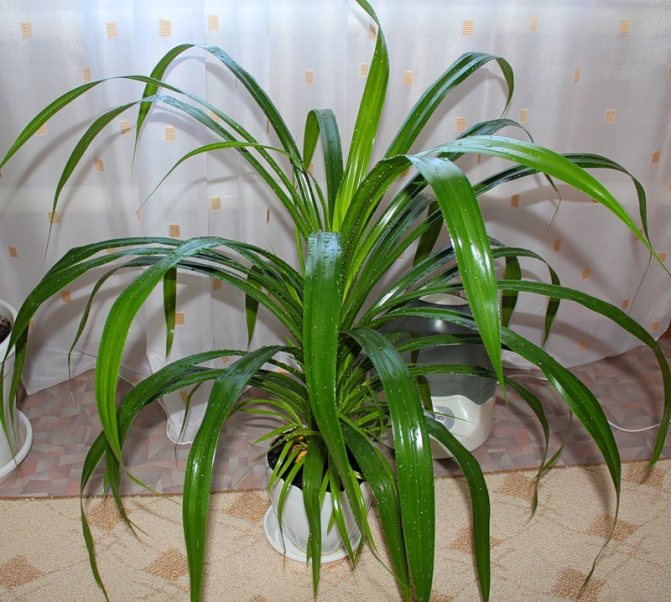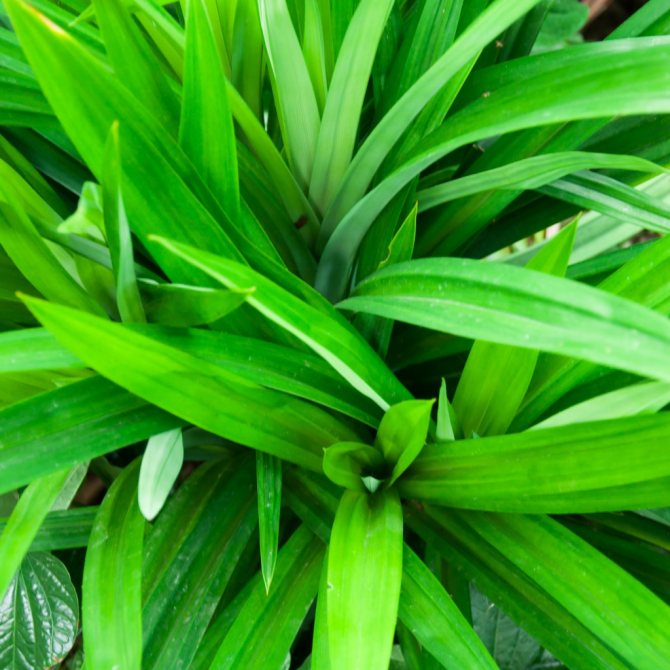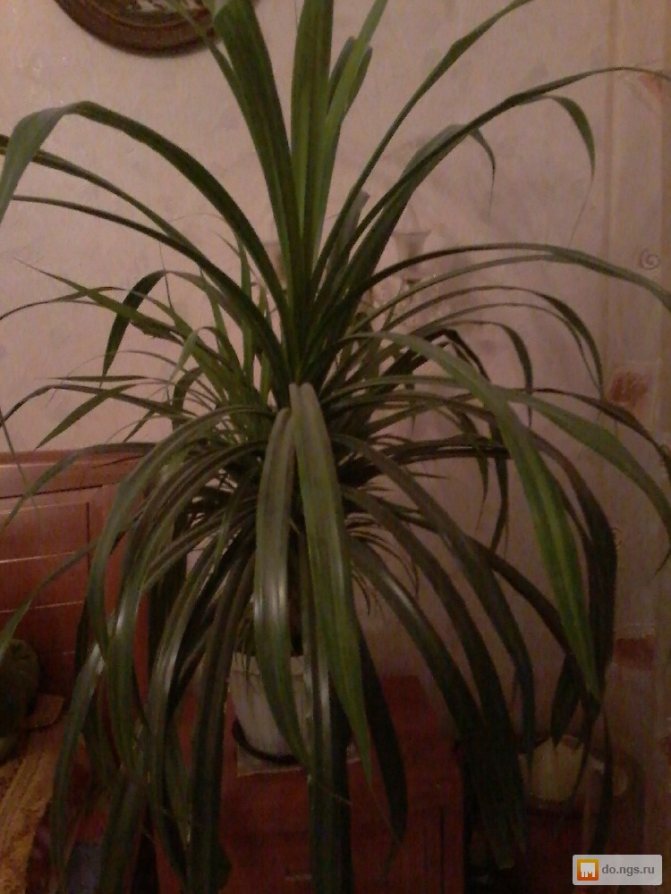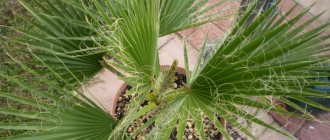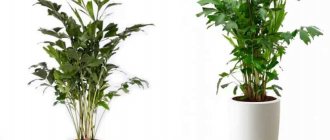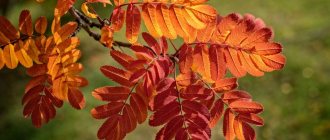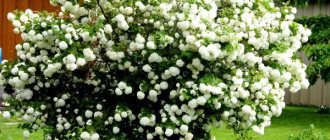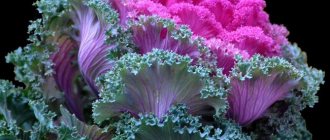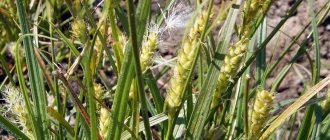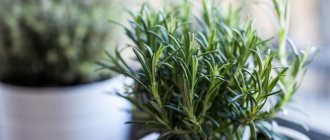Pandanus is a plant known to us for the tropical climate of the Indian Ocean islands. Favorable weather and climatic conditions of those places allow it to bloom incredibly beautifully and give amazing fruits. To obtain a similar result in our conditions, besides in a closed room, you need to try hard.
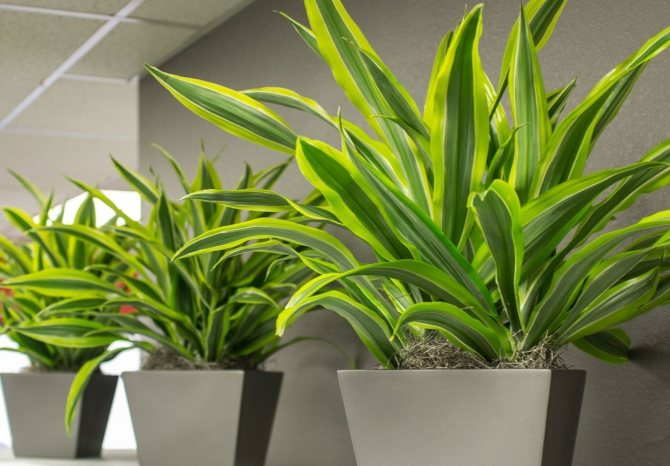
Under natural conditions, the pandanus looks like a palm tree. The main similarity between these plants is the narrow longitudinal leaves growing in a spiral. That is why the pandanus is also called the helical palm.
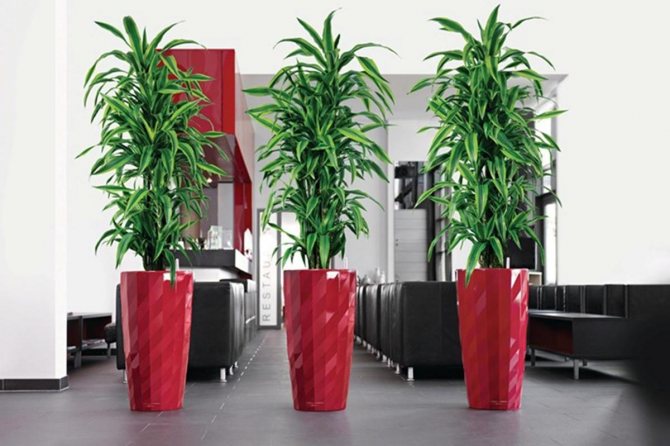

Pandanus is an unpretentious plant that does not require special care and a significant investment of time for watering and loosening. If desired, everyone can grow their own decorative spiral palm tree at home.
Varieties of pandanus (helical palm)
In nature, there are a large number of pandanus species - about 700 species. Under natural conditions, most of them produce a good harvest of fruits, similar in taste to pineapple.
Pandanus is a large plant that thrives on large indoor spaces or in a conservatory. But there are several varieties of this flower that can be successfully grown at home.
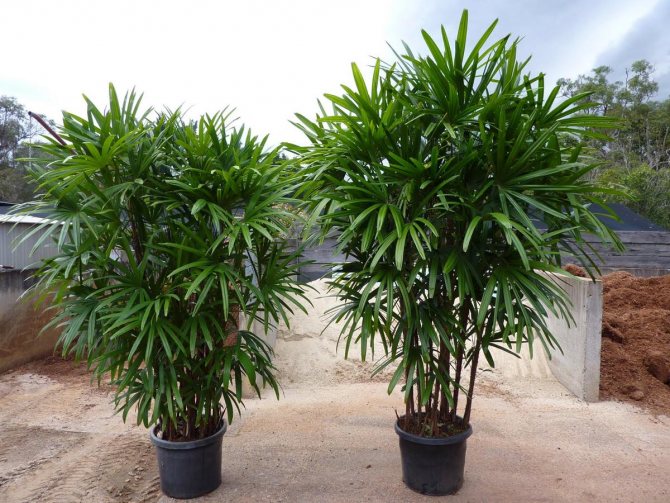

Pandanus Veitch is a shrub plant with a tree-like trunk. The maximum height is up to 1.5 m in rare cases. Bright green leaves - thin (up to 6 cm) and long (up to 90 cm) are arranged in a spiral around the trunk.
Pandanus Useful - the height of a plant in nature reaches 20 meters, at home it is not higher than 3 meters. Leaves of "Useful" are tough and straight, painted in a rich green color. The edges are framed with red thorns. The width of the leaves is up to 10 cm.
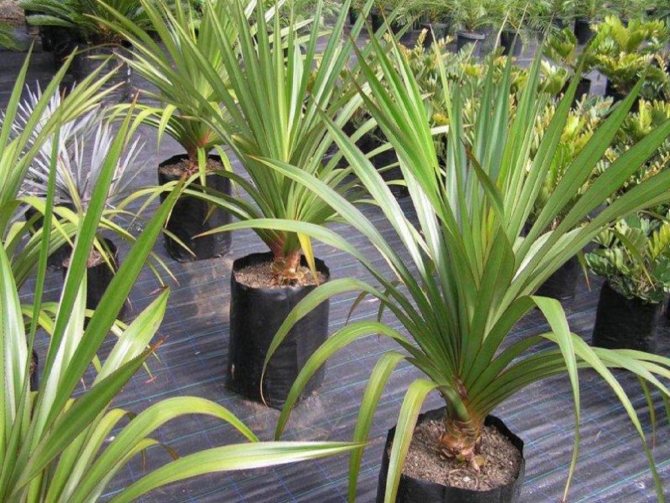

Pandanus "Sandera" is a low-growing plant species that prefers moist forest or tropical soil. The edges of the leaves are marked with small thorns, and there is a longitudinal yellow stripe in the middle.
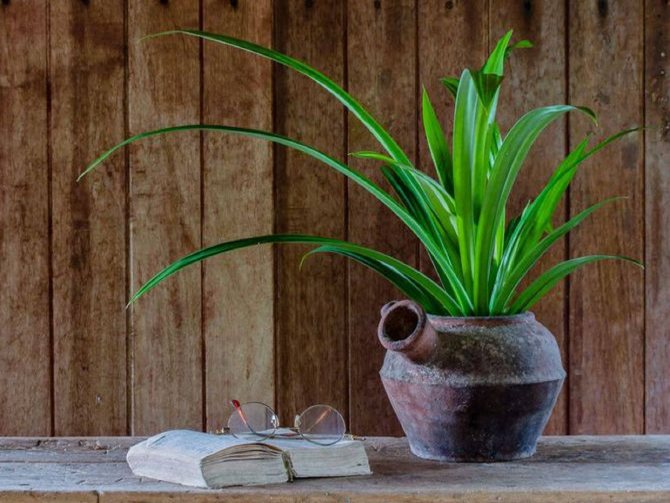

Indoor plants pandanus: flower, roots and leaves (with photo)
Pandanus is a plant with arched leaves - stripes with thorny edges, reaching a length of 90 cm and aerial roots - supports. The pandanus leaves are directed upward and form a patterned helical weave around the central rosette. A plant of the pandanov family, its homeland is the South Pacific. Pandanus loves bright, about 3 hours exposure to direct sun, moderate temperature 18 - 27C. Pandanus is an outdoor plant for large spaces that looks good next to smaller plants with graceful foliage. Look at the indoor plants pandanus in the photo, which illustrates the different types:
The genus name comes from the Malay local name for this plant.
These peculiar plants, which form the Pandapaseae family, are widespread throughout the tropical countries of the Eastern Hemisphere, but they are relatively few in America. Pandanuses are somewhat similar to yuccas, but differ from them in numerous large leaves that plant the trunk in a steep spiral. Some species are very large, like palm trees, and the original view opens up to the observer standing under one of these pandanuses and looking up at the giant plant spiral formed by the petioles of its long, drooping leaves. The trunks of some species branch into small twigs that send aerial roots downward.Other species lack a trunk and consist only of a large spiral knot of hard leaves, 10–12 feet long and only 2–3 inches wide. Pandanuses of this kind grow on islands with sandy soil, larger species grow in swampy forests. Large, somewhat pineapple-like bunches of fruit are sometimes colored bright red. Long, tough, fibrous leaves are used for wrapping boxes and boxes, as well as for other household purposes. For the indoor representative, the woody roots of the pandanus are typical, which additionally support the stem of this plant with meter-long leaves. Over time, the roots force the plant out of the pot, but this does not mean that you need to change the dishes. All the difficulties associated with breeding pandanus in living quarters relate only to its size.
The following shows a pandanus flower in a photo of various representatives of this genus:
Lighting and location of the pandanus
Pandanus is a light-loving plant that suffers from a lack of sunlight. At the same time, direct exposure to the sun also negatively affects the flower. The best place for it is the west or east side, where there is a bright and diffused light.
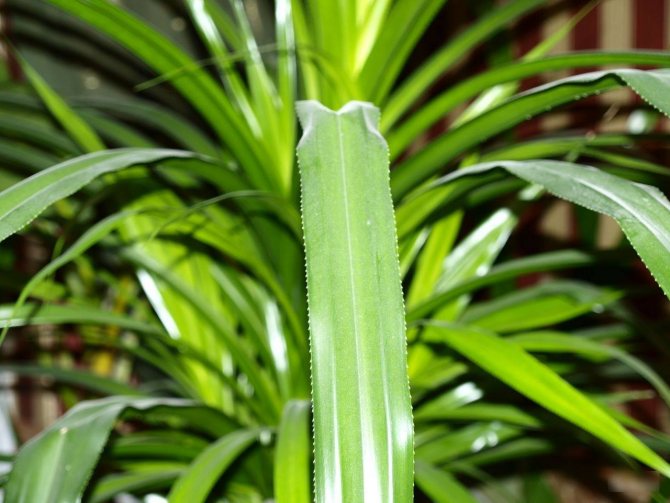

In winter, when daylight hours are significantly reduced, arrange artificial lighting with fluorescent lamps. Place them at least 1 meter from the plant and leave for at least 6 hours. Rotate the palm tree pot periodically to achieve even lighting and growth of the flower.
Pandanus is not recommended to be taken outside, as is often the case with other indoor plants. Direct sunlight will destroy the delicate structure of the palm leaves.
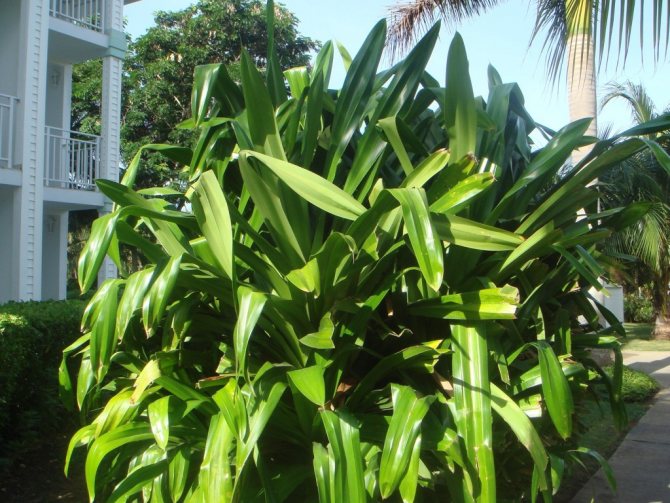

Fruits and their uses
When grown in an apartment, pandanus usually does not bear fruit... In natural conditions, fruits are formed that are used for food raw, boiled, in the form of mashed potatoes or flat cakes.
They resemble pineapples in appearance and taste. When formed, the fruits are light green in color, which eventually turns yellow, red or purple. Very light in weight.
Also, crabs and fish feed on the fruits of pandanus, which thus distribute its seeds.
Fishermen sometimes use wedges as bait.
Temperature range for pandanus
Consider the origin of the plant when choosing the best location for your pandanus. Grown in the warm climate of the Indian Islands, it will not be able to radically change the temperature regime and "love" the cool winters.
It is necessary to grow pandanus in a warm room, where the temperature in winter does not drop below 16 degrees, and in summer it does not reach above 20 degrees. The flower does not like cold drafts, while calmly refers to regular airing.
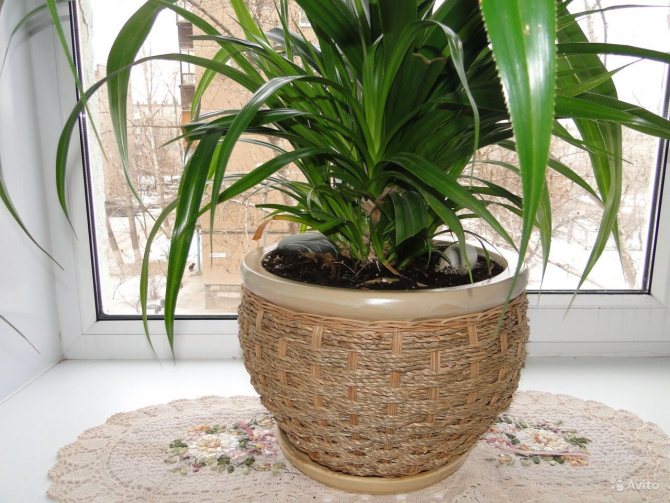

Plant care at home
Caring for a pandanus does not cause much effort, everyone can grow a screw palm at home. Due to its impressive size, it is better a large and bright room will do. Caring for this plant requires many factors to be considered.
Even if the content is far from ideal, the plant looks good and grows in size.
Illumination
Pandanus hates direct sunlight, however, his lack is also fatal to him. It is better suited for diffused light from windows directed to the east or west. It is advisable to turn the pot with pandanus by 45 degrees every week, due to this, it will overgrow with leaves evenly.
In the winter season, you need to give the plant additional lighting using lamps, the location of which should be a meter from the plant. And in the summertime, it should not be taken out into nature or on a balcony, because its growth will increase significantly.
Temperature
This family belongs to the thermophilic. Pandanus is comfortable with normal room temperature. In winter, it is better to make sure that she did not fall below 16 degrees, in summer the temperature regime should be more than 20 degrees. Despite the fact that this species does not like drafts, it is good for periodic short airing.
Air humidity and watering
Since this is a plant of the tropics, then the humidity is high. Its desirable wipe off dust, do not spray too often, at the same time, make sure that water does not accumulate in the axils of the leaves.
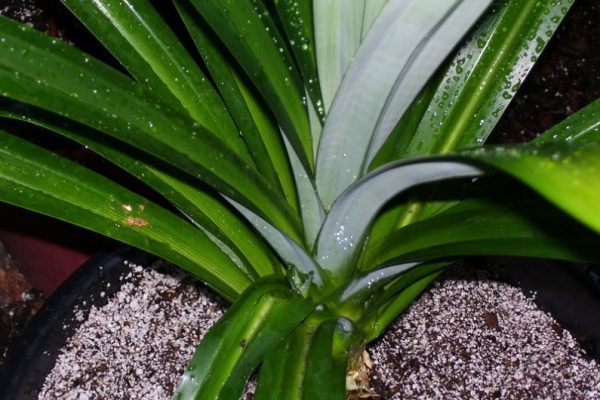

For watering a screw palm, only filtered or settled water is used.
Watering should be carried out with settled water. In warm weather, watering every second day is enough, and in winter you need to reduce the amount to 4 days, because evaporation decreases, and if you continue to water intensively, then the roots may begin to rot. The watering itself should not be abundant and untimely. They are carried out by both the upper and lower paths. The second should not be abused, since the pandanus will rapidly grow roots and will have to be transplanted.
Soil and fertilizing
For a resident of fertile soils, the room must be at least nutritious and clay-based. Suitable soil can be purchased or prepared on your own. The latter is done in this way: we take sand, leafy earth and turf, as well as humus in a ratio of 1: 1: 1: 1.
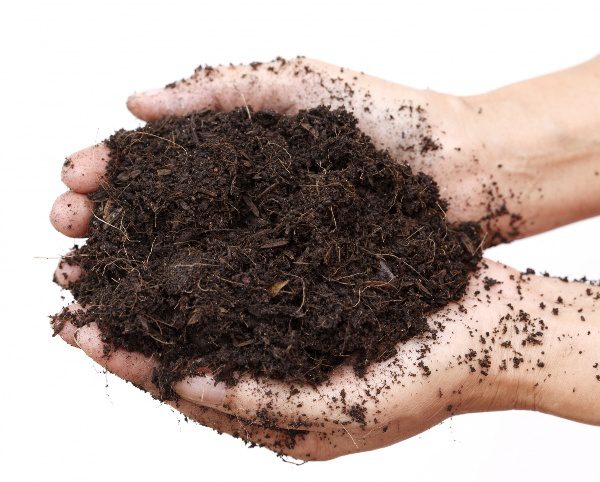

Soil for a palm tree.
Top dressing is regular. In spring and summer, they are done twice a month, in cold weather only once. Can be used like complex mineral dressing, and various liquid.
Pandanus transplant
When relocating a plant, it is best suited transshipment method... The plant is taken out together with the ground, very carefully so as not to damage the delicate roots. Pick up the pot a little more than before. It is advisable to leave it at the same level, does not need to be embedded deep into the ground.
The more transplants, the faster the growth rate of the pandanus becomes. After the palm tree reaches an adult state, it does not need transplants, but only occasionally the upper soil layer changes.
Watering and moisturizing pandanus
For watering pandanus, you must use only filtered or settled water. In warm weather, water once every two days, in winter it is enough to moisten the soil once every 3-4 days. It is important to water the plant at equal intervals, being careful not to water it. An excess of moisture has a bad effect on the flower, which can lead to decay.
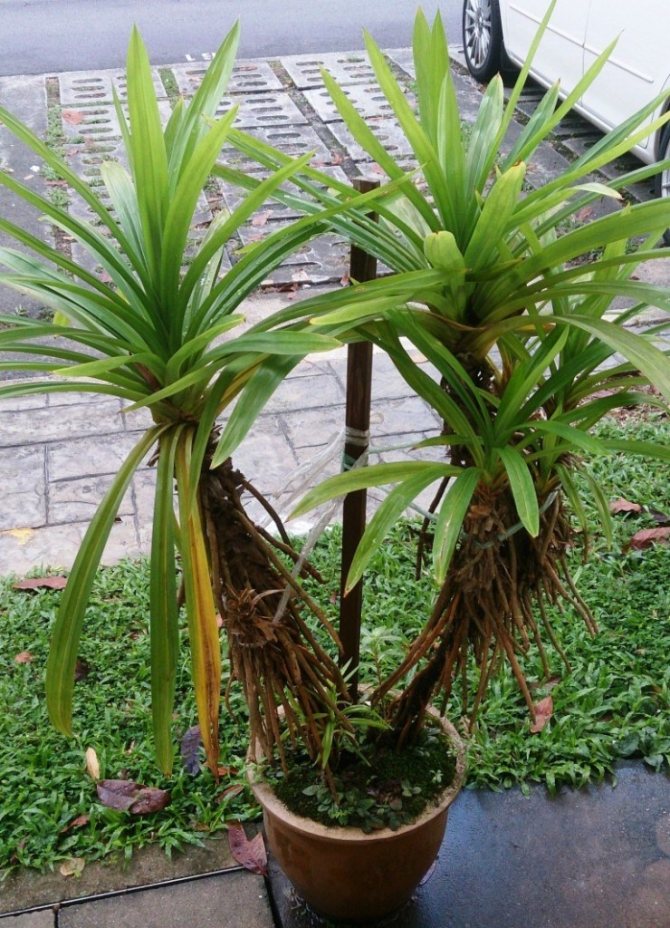

Pandanus has no special requirements for air humidity. He normally perceives dry air. However, the indoor palm still needs to be sprayed a couple of times a month to remove dust from the leaves.
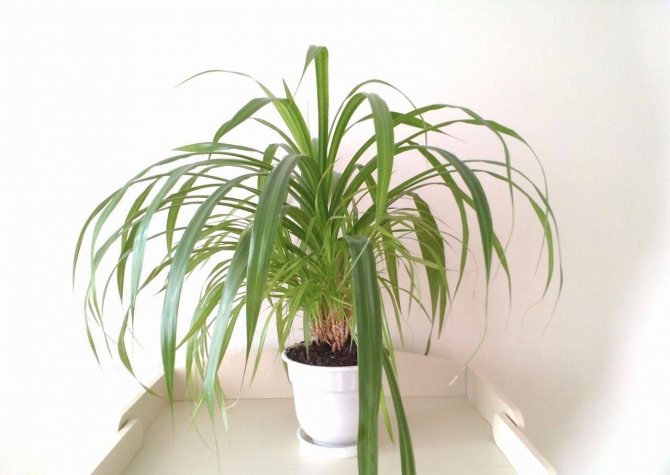

Views
There are over 600 different species of pandanus, the most famous of which are:
- Hiding behind Is an evergreen shrub with aerial roots, which grows 3-4 meters in natural conditions. Gradually, the outer roots grow into the ground, and the trunk rotted under them, which is why the plant begins to be held only by them. The plant produces sweet orange or red fruits.
- Sander Is a tree with a short trunk. Its leaves are long, with yellow stripes in the middle. They grow up to 80 centimeters long and 5 centimeters wide. The edges of the leaves are spiked.
- Useful - when grown in a room, it can grow up to 2-3 meters in height. After the formation of inflorescences, it branches. The leaves grow in a spiral, up to 1 meter long and up to 10 centimeters wide. Red thorns are located along the edges.
- Veitch - an evergreen plant with a short trunk, from which aerial roots extend. Like the covering pandanus, in this species the lower part of the trunk also rotted during aging. Leaves 60-90 centimeters in size grow very densely in an upward spiral. There is a white stripe and a row of small thorns along the edge of the leaf.Almost does not bloom in an apartment. When creating a favorable environment, it can grow to a height of 1.5 meters in 10 years.
Photo: helical palm (pandanus) hiding behind.
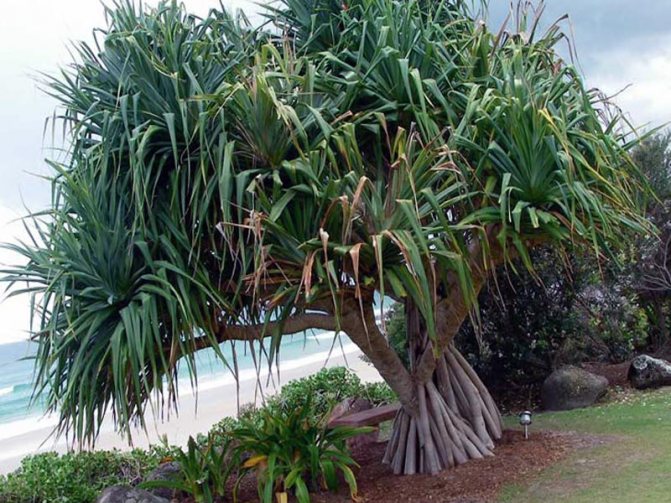



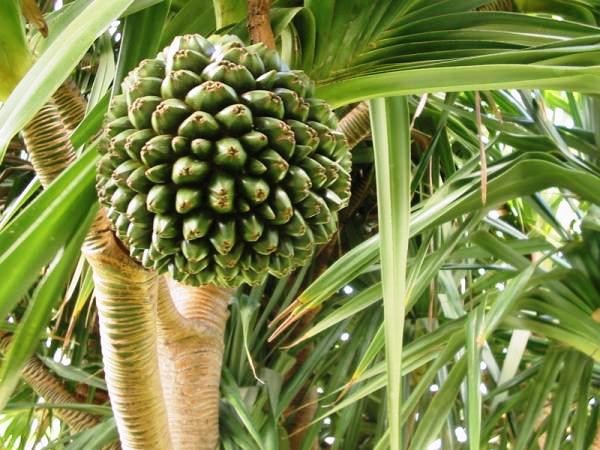

Soil and food for pandanus
The helix palm loves rich, nutritious soil with little clay. You can use ready-made palm potting mix or make your own. To do this, mix in equal parts sand, humus, turf and leafy soil.
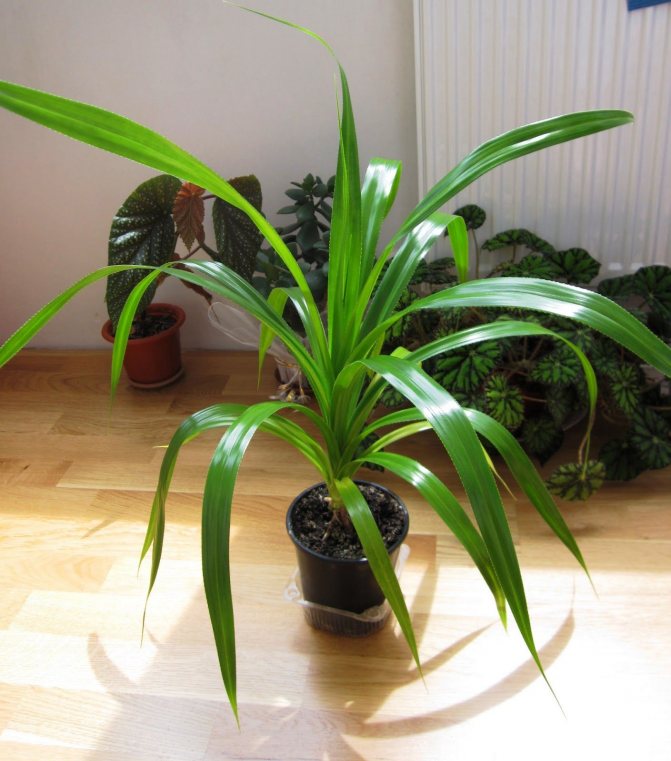

Growing at home, pandanus needs regular feeding. In the summer, you need to apply fertilizers to the ground 2 times a month, in the winter 1 time is enough. Use ready-to-use liquid dressings for indoor plants.
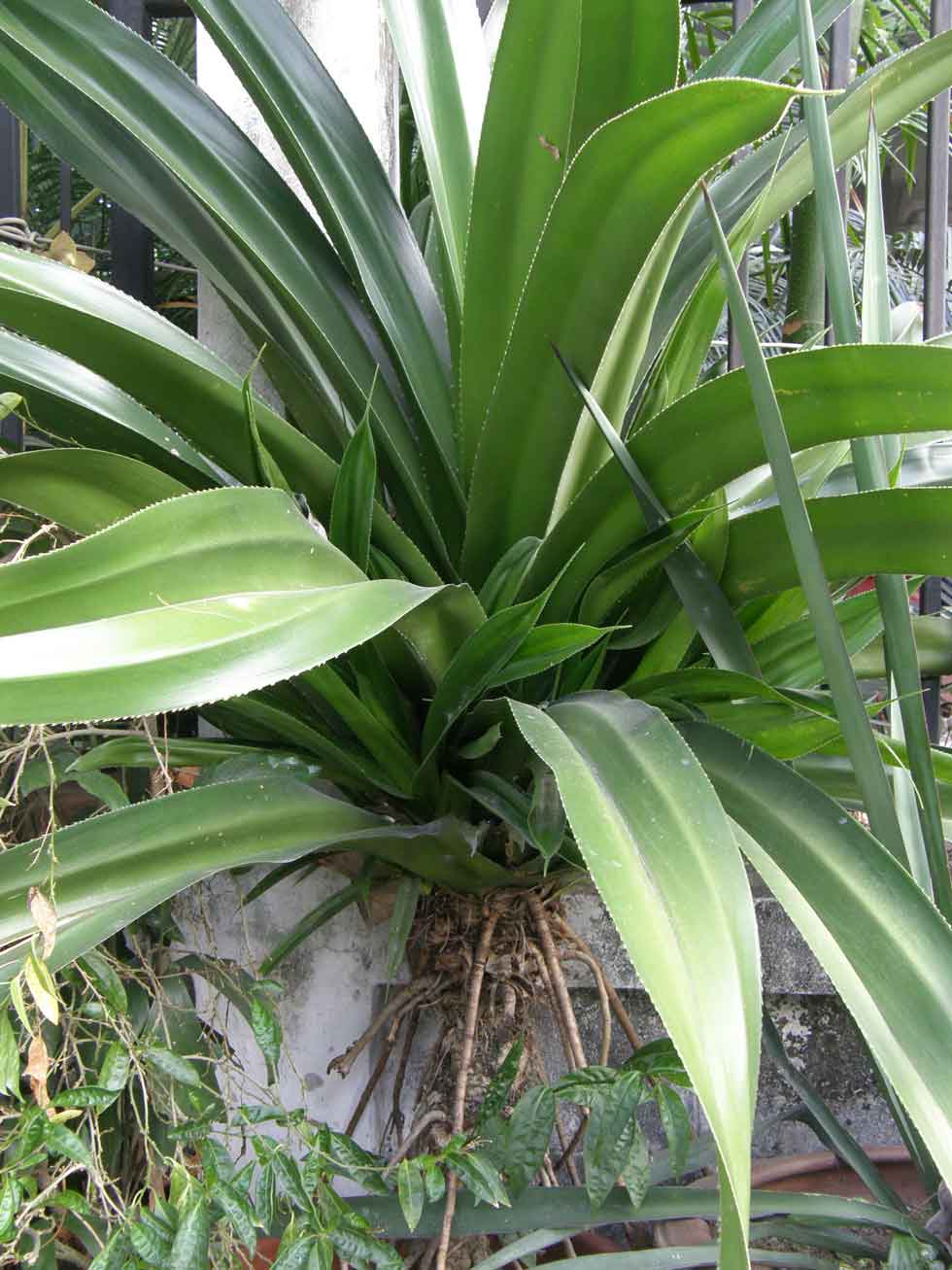

Transfer
For young plants, a transplant is required at least once a year, and after several years, this period increases to 2-3 years (provided that the soil is completely entwined with roots). This can be determined visually when the roots begin to bulge out of the pot.
The thick and powerful roots of the pandanus are actually very fragile. When transplanting, it is important that they are not harmed.
You should carefully consider not only the choice of the pot (its size should not be very different from the previous one), but also its filling. At least a third of the pot should be made up of a drainage layer. The rest is filled with soil, humus, sod soil and sand.
All proportions must be respected in equal amounts... It is also possible to land in ready-made soil. The most suitable of the specialized will be a mixture for palm crops.
If your "favorite" is large, it is recommended carefully tie the leaves before all the manipulations. Thus, the likelihood of damage to the plant will be significantly reduced.
Pandanus transplant
As the indoor palm grows and develops, it needs a transplant. Young plants need replanting every spring, adults after 2-3 years. The first sign that the flower is cramped is the braiding of the entire earth in the pot by the root system.
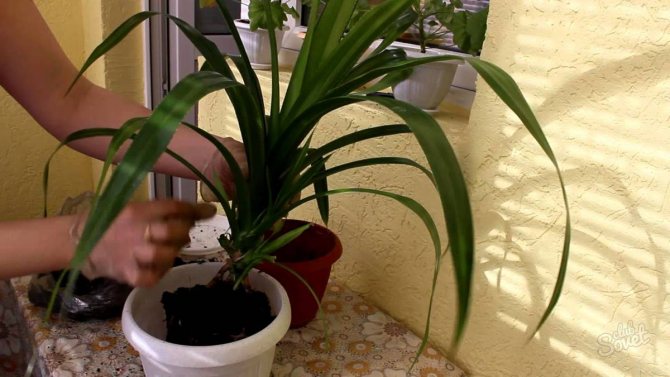

Pandanus is transplanted by transshipment. To do this, the earthen lump is carefully taken out of the old container and transferred to a new pot, being careful not to damage the fragile roots of the flower.
It is better to tie the leaves of the palm tree into a bunch before transplanting. This will prevent your hands from getting hurt on the thorny thorns or damaging the plant.
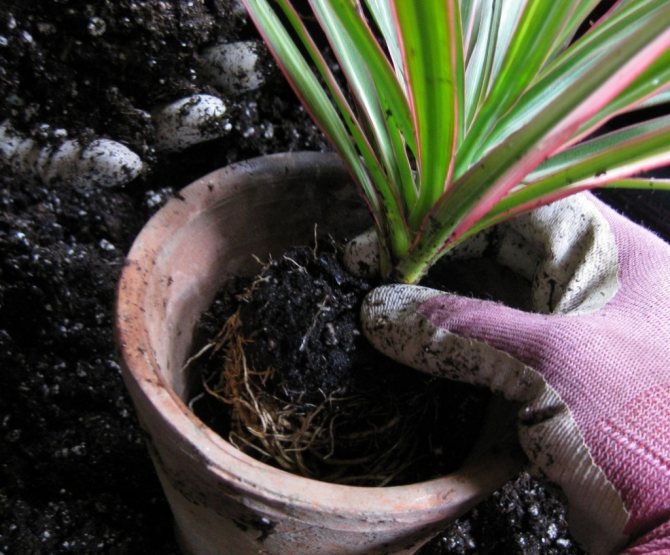

It is necessary to transplant a palm tree into a pot slightly larger than the previous one. Do not place a young palm tree in a large pot. The roots will not take root in it due to the large amount of soil and gradually they will begin to rot.
The more often a palm tree is replanted, the faster it grows. You can take note of this if you want to slow down the growth of the flower.
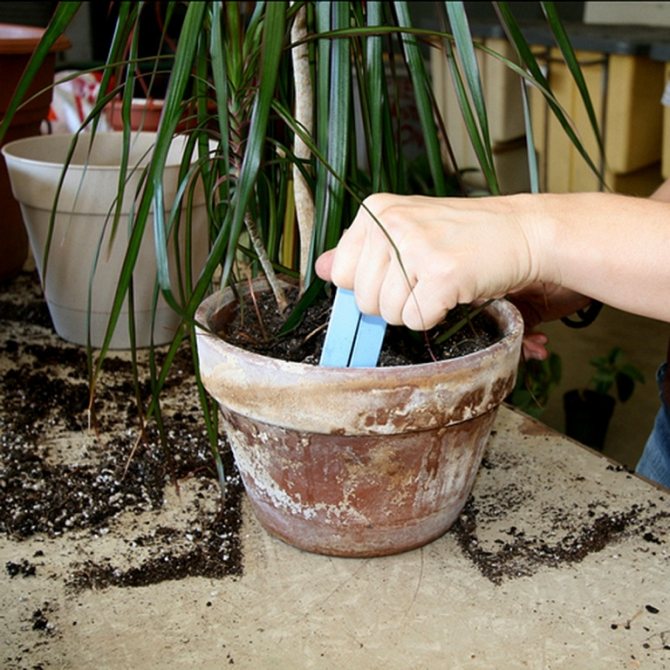

Mature plants growing in large tubs no longer need replanting. The root system of the palm tree is fully formed and all it needs is periodic soil renewal.
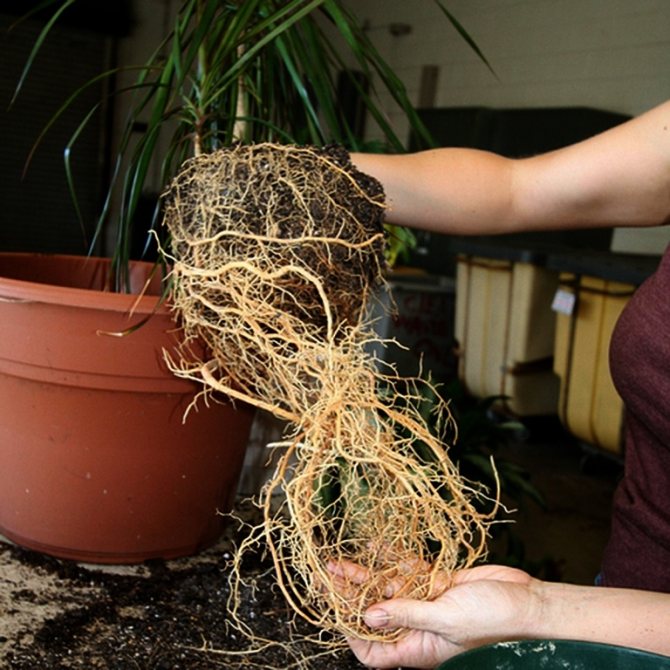

General information about the pandanus
In nature, there are more than 500 different species of the Pandanovaceae family. Their homeland is on subtropical and tropical lands... They are native to Africa, India, Nepal and Madagascar.
Among the representatives of this group, common features can be distinguished:
- leaves are dense, narrow and long, often with needles at the ends; leaf height ranges from 15 cm to several meters, and width from 1.5 to 12 cm.
- the trunk is short, relative to the size of the whole plant; has massive roots, and after the separation of old leaves, it acquires a specific color, thanks to which it becomes similar to a palm tree.
- in ornamental species there is a weak pleasant aroma.
- are tree-like.
- centenarians.
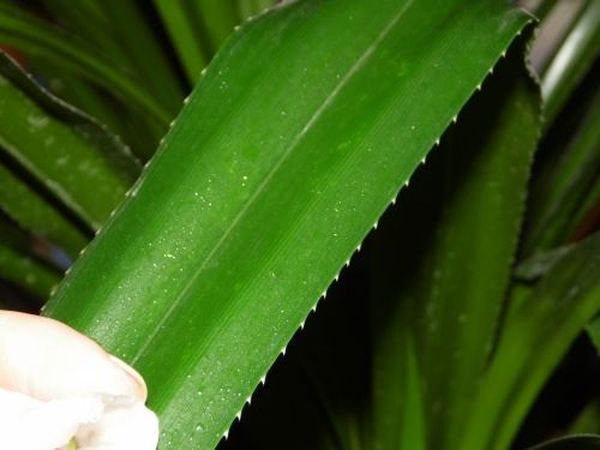

Pandanus leaves have sharp needles
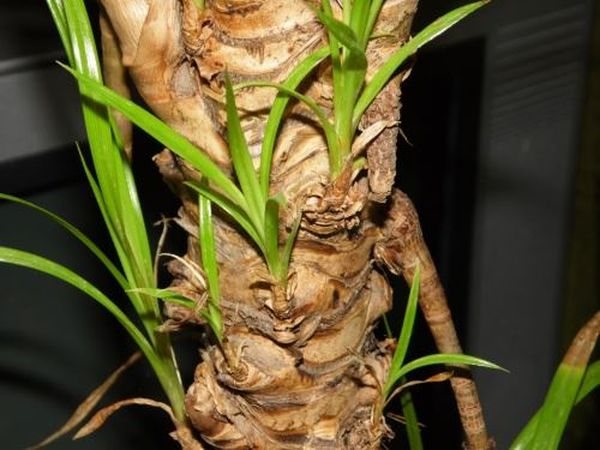

The trunk is treelike
Propagation of room palm by cuttings
For propagation by cuttings, use stems about 20 cm long. The short twigs form roots very slowly.
Places of cuts are treated with charcoal or activated carbon. Each stalk is placed in a prepared pot filled with a mixture of peat earth and sand.From above, the seedlings are covered with a transparent film, thereby creating favorable greenhouse conditions. The temperature in the "greenhouse" should be at least 25-28 degrees. At the same time, periodically open the film to air the sprouts.
Rooting of cuttings takes place within 2 months. Use root growth stimulants to speed up the process.
Pests
- Pandanus rarely gets sick, but if you notice that the "favorite" has begun to dry out, and the leaves have lost their former beauty, then carefully examine the plant. This may be due to scabbards... They "sit" motionless on the flower.
- If the leaves have become lethargic, take a good look at the parts of the plant adjacent to the trunk. Perhaps "on a visit" to the pandanus looked spider mite... The vital activity of this parasite is detrimental to the plant.
- Mealybug - the third enemy of palm crops. Unlike other parasites, it can be detected with an unarmed look. The length is from 5 to 10 mm, they have a light (white) color. Worms are dangerous because, in addition to the trunk, they often affect the roots.
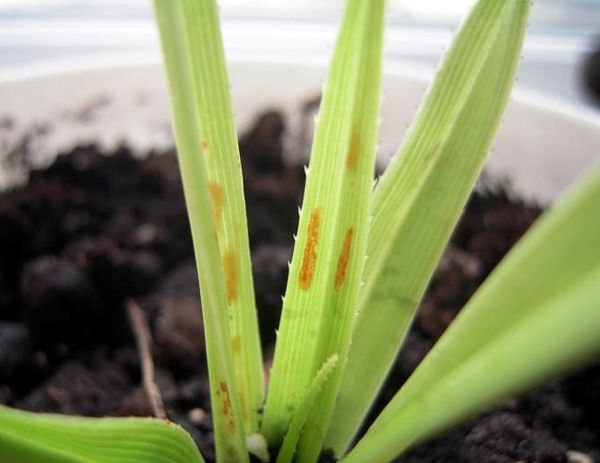

Red spider mite on pandanus
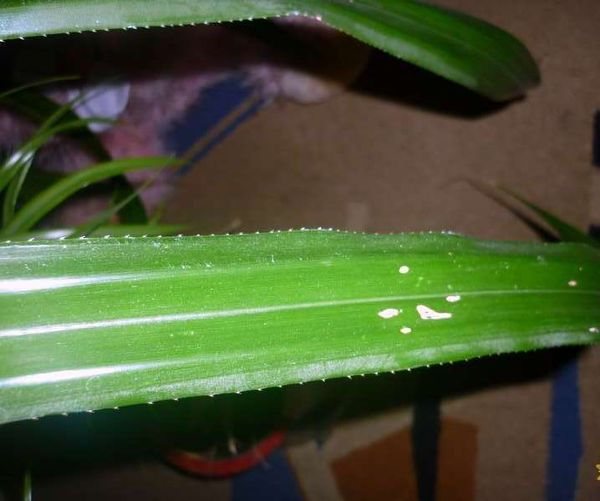

Defeat by the scabbard
In the fight against every pest, there are folk and professional remedies.
- soap solution;
- infusion of tobacco;
- weak manganese solution;
- fumigation with sulfur;
- insecticides (Karbofos, Fitoferm, Aktellik, Aktara).
Before proceeding with the treatment of a flower with chemical preparations, it is necessary to consult a specialist.
Propagation of pandanus by seeds
One of the easiest ways to propagate a palm tree is by seed. No prior preparation is required. It is enough to place the pandanus seeds in a pot of peat soil and cover it with foil. After 15 days, the first shoots appear. They are cared for by timely soil moisture and airing.
Seedlings are transplanted into separate containers when a third full-fledged leaf appears on them.
Poisonousness - is it possible to keep at home
It is very important to know what kind of plant you need to care for - some can be dangerous.
Potential threats are not only needles, but also fruits and leaves Pandanus plants. If there are curious kids in the house, then you should not risk their health and keep it at home.
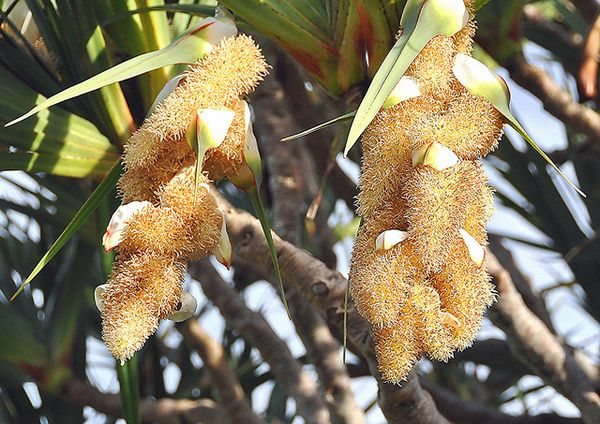

Pandanus fruits can be dangerous to children
Reproduction of a palm tree by division
The best time to divide is early spring. Daughter sockets with roots are "pinched off" from an adult plant and left to dry for a day. After that, they are planted in a separate container with enriched peat soil.
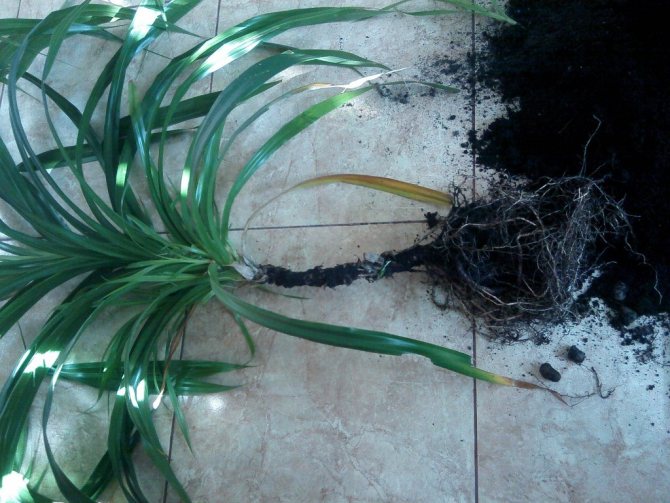

The preparation of the container is of great importance for the growth and development of the flower. At the bottom of the pot, a 2 cm layer of drainage should be placed, consisting of washed sand and clay shards. A layer of sod is placed on top of it - up to 7 cm, the top layer is river sand. It is in such a "pie" that the pandanus will actively take root and develop.
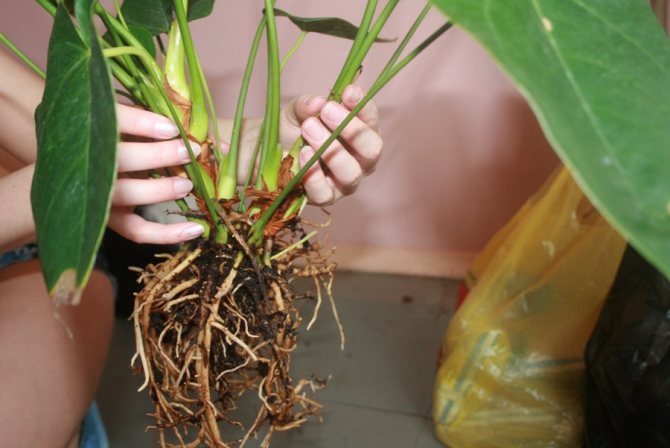

Decorative palms are firmly established not only in apartments, but also in office premises. A beautiful type of plant, striking in its majesty, fits into any interior. Easy care of pandanus makes it the best decoration for spacious rooms.
Diseases and pests
The plant is very rarely affected by pests, but it can still suffer from the shield... It looks like brown bumps on the leaf surface. For treatment, it is necessary to carefully treat them with a sponge with a soapy solution (it should be remembered that water stagnation in the sinuses should not be allowed) or sprayed with special insecticides.
Yellowing and dying off of the lower leaves Is a natural aging process for a plant. They must be independently removed from the trunk with sharp scissors. The ends of the leaves can dry out - this is an indicator of too dry indoor air or mineral depletion of the soil. In the latter case, you need to apply top dressing.
For exotic lovers, we recommend reading our articles on growing and caring for Dracena, Hamedorea, Gomuti, Chrysalidocarpus, Washingtonia, as well as coconut, date, rattan, as well as Rapis and Cariota palms.
Plant properties
Keep in mind that the pandanus flower is, in fact, a whole living organism that needs careful care, and under severe stressful situations it may well die. However, the flower also has a number of positive aspects, such as:
- saturation of the house with positive energy;
- improving brain function;
- stimulation of sluggish and inactive people to action;
- In the tropics, the leaves of the flower are used for medicinal purposes, for example, they chew the leaves for inflammation of the gums or in order to relieve toothaches.
The benefits of pandanus are all about its fruits
in room conditions, waiting for the pandanus to bloom will not work
The pandanus fruit looks quite original, which is very similar to pineapple. However, it is more round. Fruits are considered ripe when they acquire a deep red color, and until that moment they are green or red. Although depending on the place of cultivation, pandanus fruits may differ: in some places, berries that have yellow, blue or orange color can ripen.
Pandandus
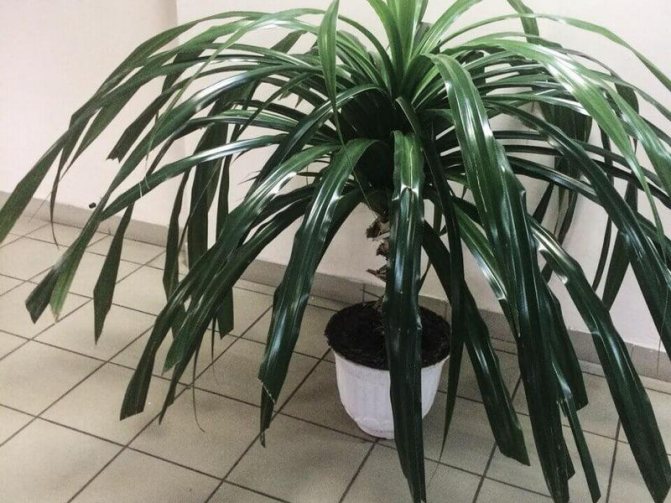

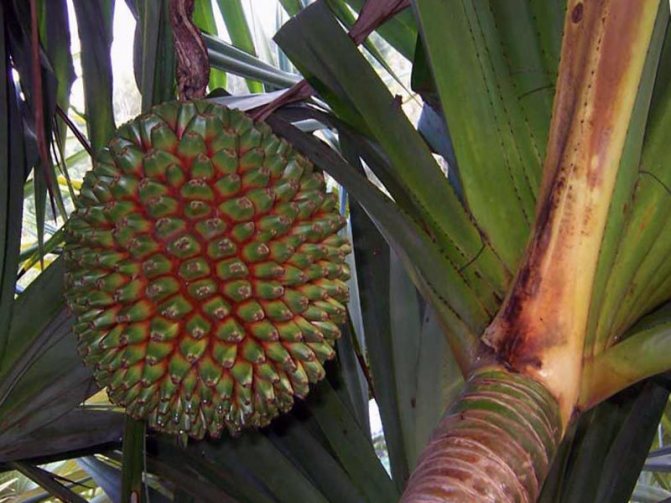

Among the varieties of pandanus, there are those on which fruits suitable for food grow. Therefore, many species of animals often do not disdain them: crabs, elephants and bats. The local population does not refuse them either, using the fruits for the preparation of various dishes. Moreover, the fruits of pandanus are interesting not only because of their pleasant taste, but also because of their beneficial properties:
- ascorbic acid;
- cellulose;
- folic acid, which pregnant women so need;
- contains a large amount of potassium, phosphorus and enzymes that improve the activity of the nervous system.
This fruit is not offered for sale; it is not a good idea to use pandanus fruits grown in greenhouses and at home for food, since in their taste and useful properties they differ from fruits growing in natural conditions.
How to propagate pandanus?
You can grow a false palm from both shoots and cuttings. Each of the methods has its own characteristics.
Rooting of shoots
Children cut from the trunk of a plant, already having 2-3 cm roots, are very easy to root. You can accelerate the formation of aerial roots by wrapping the lower part of the trunk with moistened sphagnum moss.
The shoots should be dried in air for 10-12 hours, and then placed in a substrate that is nutritious and breathable.
The container with children is covered with glass or cellophane. It is important to maintain a stable temperature of about +22 - + 24 degrees and periodically moisten the soil from a spray bottle. After rooting, the covering material is removed.
Cuttings
Side shoots can be used to propagate pandanus. They are cut, dried, and the cuts are sprinkled with activated or charcoal powder.
Cuttings are planted according to the same algorithm as the children. They need the same care.
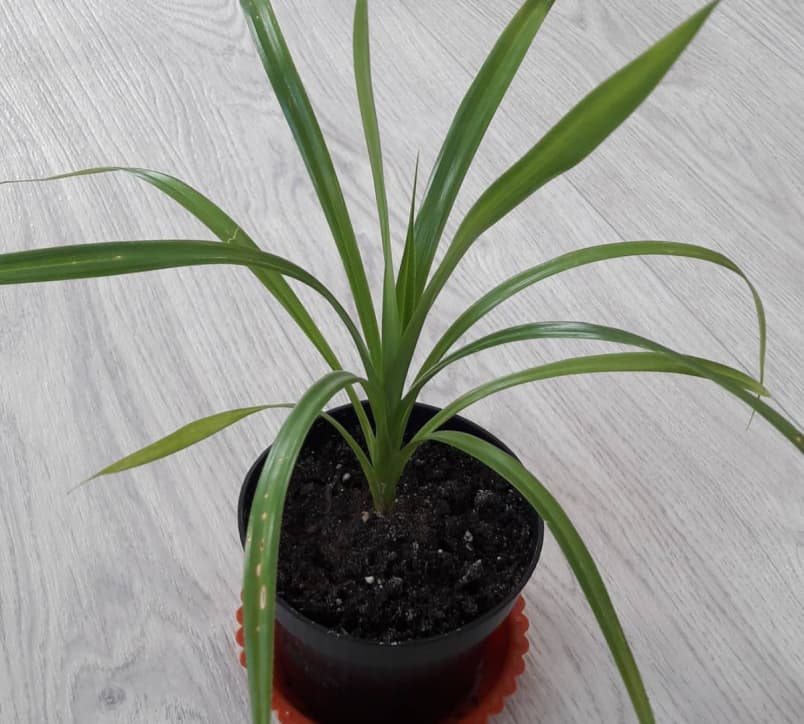

Insect pests and diseases
It is believed that pandanus has a high immunity to various pests, but if not properly cared for, it can be attacked by various insects. Popular ones are scale insects, scale insects or spider mites. Signs of the appearance of a scale insect will be formed scales of a dark color, and the leaves will become sticky.
To rid the pandanus of these pests, it is necessary to treat it with actellik or krbofos. If a mealybug is affected, pandanus should be treated with a special anti-acaricidal agent. Diclox or Tolcox will work well. With a lack of air humidity, this plant can be infected by spider mites. Signs of their appearance are small dots on the leaf, which eventually merge into a large spot.If these signs are found, acaricidal agents should be used. Actellik or Aktara have proven themselves well.
After that, it is necessary to increase the humidity in the room. You can use a humidifier or add moistened pebbles or expanded clay to the pan.
Of the diseases common for pandanus, only a change in the color of the leaves can be distinguished: they turn yellow if you water the plant with hard water, and this can also happen with a lack of light or with an excess of calcium in the soil.
If the plant is in a dark room, then the leaves may become small and discolored. In addition, if the air is excessively dry, they will turn brown and the tips of the leaves will dry out.
All these problems are eliminated by increasing the humidity of the air using humidifiers or placing the pot in a pallet with expanded clay.
The nuances of growing in an apartment


Veitch's young indoor pandanus looks like a dracaena. There are external similarities, but there are also significant differences that must be taken into account. One or more pandanus stems are not as neat as dracaena. With age, the trunk near the ground becomes thinner or rotted. The crown is supported by aerial roots of varying thickness and length. It is not necessary to cut off these "pencils" sticking out in different directions.
The lowest adventitious roots go deeper into the soil and support a powerful plant.
The adult pandanus has long, tough, thorny leaves that require plenty of room to grow freely. A light hall, a glazed loggia, a winter garden are more suitable for the plant. An adult pandanus looks much more impressive than a young one. Monochromatic leaves in good light are uniformly bright green, shiny. Variegated pandanuses lose their leaf pattern without light.
Botanical description
Pandanus is an evergreen perennial, in its natural environment it can reach over 13 m in height. An indoor plant rarely exceeds 3 meters in height. Thick, dense roots go deep into the ground. It is noteworthy that the flower has not only an underground, but also an aerial rhizome.
Above the ground is a smooth, short trunk covered with light brown bark. It is almost completely hidden under sessile leaves. The top is decorated with a spreading crown of many belt-like leaves. They grow along the stem in a spiral. The leaves at the base are tightly adjacent to each other. The leaf has a pronounced central vein and a bright green color. The length of the plate is 60-120 cm, and the width is 3-8 cm. On the sides of the leaf, as well as on the bottom along the central vein, there are short but very sharp spines. They grow at an angle towards the edge of the leaf.
In its natural environment, the pandanus spiral palm produces flowers annually. One tree contains spike-shaped male inflorescences and female cone-shaped flowers. As a result of pollination, large edible fruits are formed, similar to a rounded pineapple. They have a pleasant sweetish taste and contain medium-sized seeds. Alas, it is almost impossible to achieve flowering of indoor pandan.
Conditions of detention depending on the season
| Season | Humidity | Content temperature | Lighting |
| Spring-summer | Pandanus tolerates dry indoor air well, but it is impossible to constantly keep the plant at low humidity, the flower may die. The optimal level should be 60%. It can be achieved through periodic leaf spraying. | + 20-22 оС | The helix palm requires bright, but diffused light. To avoid burns, the pandanus should be placed against the east or southeast window, which is curtained with tulle. Some species (with green leaves) are shade-tolerant. A pot with green-leaved pandanus can be placed in the back of the room. |
| Autumn-winter | With the onset of the heating season, the plant should be placed away from the batteries and the pot should be placed on a pallet with wet expanded clay or pebbles.This technique will allow you to maintain the required humidity level. | + 18–20 оС. It can withstand a short-term temperature drop of up to 12 degrees. | In winter, the flower is best placed near a South-facing window. If the plant is large and it is problematic to put it on the windowsill, then you should arrange additional illumination for the pandanus using a phytolamp installed at a distance of 30–40 cm from the crown of the flower. |
Pandanus in a bottle garden or florarium
Florariums have become very popular. You can place several plants in them, creating beautiful compositions from them. Florists sometimes wonder if pandanus can be grown this way. Due to its impressive size, pandanus is not suitable for growing in florariums. For the full development and growth of the helical palm, space is needed. In addition, the high humidity inside the bottle garden will not benefit the flower.
For the full development and growth of a spiral palm, free space is needed
Harmful properties of the fruit
Of the harmful properties, one can single out the fact that some types of pandanus are the strongest allergens, and not the fruits, but the leaf of the plant. Therefore, before acquiring this indoor beauty, make sure that neither you nor your children have an allergic reaction to the leaves or pollen of the pandanus plant.
And the second thing that can be distinguished when studying pandanus is individual intolerance when eaten. Try a new fruit piece by piece and control your well-being.
About diseases and parasites
If a palm tree is properly cared for and kept in suitable conditions, it is extremely rare for it to get sick. Most of the ailments are associated with violation of the detention regime:
- The foliage dries out, starting from the tips - a sign of dry air and / or lack of water in the soil.
- Fall of the lower leaves - this symptom is associated with natural aging. But if the process is too intense, then perhaps the plant does not have enough moisture.
- Shrinking foliage, slowing palm growth and the disappearance of light stripes in variegated varieties - signals insufficient lighting.
- Brownish spots on the plates - possibly sunburn.
- Leaves become discolored - most often this happens when the pandanus is watered with hard water.
- The foliage turns yellow - an alarming phenomenon, indicating the development of rot in the root system. Rot occurs when the soil is waterlogged against a background of low temperatures. And also the leaves can turn yellow as a result of insufficient watering.
Pests are not particularly interested in indoor pandanus. Unless the most indiscriminate of them - mealybugs, spider mites and representatives of the scale insect family - can encroach on the exotic. A small colony of parasites can be removed by treating the plant with soapy water. If there are a lot of insects, then it is worth resorting to more effective insecticidal preparations.
It is important! It should be borne in mind that the use of several means may be required to combat shield insects, since parasites are equipped with protective shields and may be immune to the action of many chemicals.
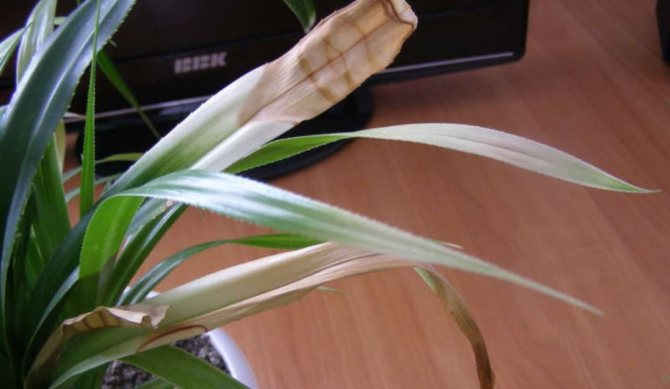

Excerpt from Pandanus (plant)
- Baton de gueules, engrele de gueules d'azur - maison Conde, [A phrase that cannot be translated literally, since it consists of conventional heraldic terms that are not quite accurately used. The general meaning is this: The coat of arms of Condé represents a shield with red and blue narrow jagged stripes,] he said. The princess listened, smiling. “If Bonaparte remains on the throne of France for another year,” the Viscount continued the conversation he had begun, with the air of a man not listening to others, but in a matter he knew best of all, following only the course of his thoughts, then things would go too far. By intrigue, violence, expulsion, executions, society, I mean a good society, French, will be destroyed forever, and then ... He shrugged his shoulders and threw up his hands.Pierre was about to say something: the conversation interested him, but Anna Pavlovna, who was on guard, interrupted him. “Emperor Alexander,” she said with the sadness that always accompanied her speeches about the imperial family, “announced that he would leave the French themselves to choose the mode of government. And I think there is no doubt that the whole nation, freed from the usurper, will throw itself into the hands of the rightful king, ”said Anna Pavlovna, trying to be kind to the emigrant and royalist. “This is doubtful,” said Prince Andrew. - Monsieur le vicomte [Monsieur Viscount] quite rightly believes that things have gone too far. I think it will be difficult to go back to the old. - How many I heard, - blushing, Pierre again intervened in the conversation, - almost all the nobility has already gone over to Bonaparte's side. “This is what the Bonapartists say,” said the Viscount, without looking at Pierre. - Now it is difficult to find out the public opinion of France. - Bonaparte l'a dit, [This was said by Bonaparte,] - said Prince Andrew with a grin. (It was evident that he did not like the viscount, and that, although he did not look at him, he turned his speeches against him.) - "Je leur ai montre le chemin de la gloire" - he said after a short silence, again repeating the words Napoleon: - “ils n'en ont pas voulu; je leur ai ouvert mes antichambres, ils se sont precipites en foule "... Je ne sais pas a quel point il a eu le droit de le dire. [I showed them the way of glory: they didn't want to; I opened my front for them: they rushed in a crowd ... I don't know to what extent he had the right to say that.] - Aucun, [Nothing,] - objected the viscount. “After the murder of the duke, even the most biased people stopped seeing him as a hero. Si meme ca a ete un heros pour certaines gens, - said the Viscount, addressing Anna Pavlovna, - depuis l’assassinat du duc il y a un Marietyr de plus dans le ciel, un heros de moins sur la terre. [If he was a hero for some people, then after the murder of the duke there was one more martyr in heaven and one less hero on earth.] Before Anna Pavlovna and the others had time to appreciate these words of the Viscount with a smile, Pierre again burst into the conversation, and Anna Pavlovna, although she had a presentiment that he would say something indecent, could no longer stop him. “The execution of the Duke of Enghien,” said Monsieur Pierre, “was a necessity for the state; and I just see the greatness of the soul in the fact that Napoleon was not afraid to take responsibility for this act alone. - Dieul mon Dieu! [God! my God!] - Anna Pavlovna said in a terrible whisper. - Comment, M. Pierre, vous trouvez que l'assassinat est grandeur d'ame, [How, Monsieur Pierre, you see the greatness of the soul in murder,] said the little princess, smiling and pushing her work closer to her.
Indoor flowers pandanus: description of leaves and fruits
Pandanus has been described elsewhere as a tropical plant that can grow to impressive sizes in the wild. In Madagascar, Vietnam and the islands of the Indian Ocean, there are specimens up to 20 meters in height. These are large plants with a strong trunk and powerful root system. A feature of the pseudopalm is that it has the ability to form aerial roots slightly higher at the base of the trunk, which eventually go into the depths of the soil, less often they become detached. In the wild, you can often find pandanus flowers as if standing on "stilts" (numerous roots).
The root system, expanding, contributes to the death of the lower part of the trunk and keeps a large plant due to the fact that it goes deep into the ground. Indoor flowers pandanus with such a superficial rhizome are extremely rare.
The trunk of the plant is strong, broad and well-branched.
On it are the xiphoid leaves of the pandanus, which tightly cover its base with the lower part of the plate. Heavy, needle-like green "belts" grow in a spiral on the trunk. After the leaves die off, they leave scars. They are especially noticeable in mature plants, which have the ability to shed the lower plates. When examining their trunk, it seems as if it is twisted in a spiral. The surface of the leaves is painted in different shades of green, light longitudinal stripes and sharp jagged thorns along the edges give additional decorative effect.
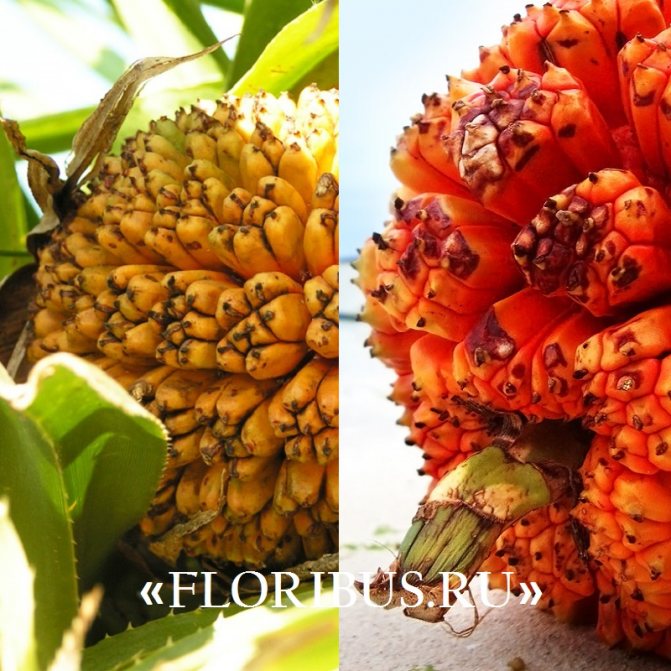

In the wild and in culture in warm countries, in particular in India, the spiral palm tree blooms. Its flowers are divided into female and male, respectively, the plants are divided on this basis.Male buds are large, fragrant, 3-4 cm long and surrounded by white bracts. Female flowers immediately appear with fruits similar in structure to pineapple. These are spherical fleshy fruits up to 10-20 cm in diameter.
The surface of the fruit is a plurality of prisms. As it ripens, the fruit changes color from deep green to red brick. In India, some species bear fruit with edible fruits, but it is mainly a forage crop that crabs, monitor lizards and other animals feed on, spreading seeds naturally.
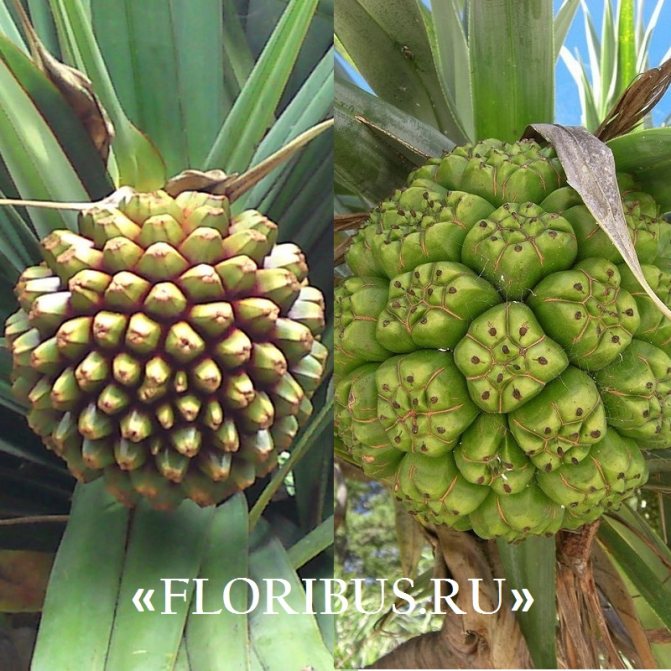

The pandanus fruit is quite large and looks like large, round buds.
When grown indoors, pandanus is significantly different from those that can be seen in the wild. For starters, the pot does not allow the plant to grow more than 3 meters in height (this should be considered when growing in small spaces). Also, pay attention to the fact that the plant is fast growing and can gain the bulk in 4-5 years. In indoor conditions, the plant does not bloom and does not bear fruit, but with proper lighting it can amaze with the decorativeness of green screw belts. Pandanus leaves are the main value that gives a decorative look to the house plant.
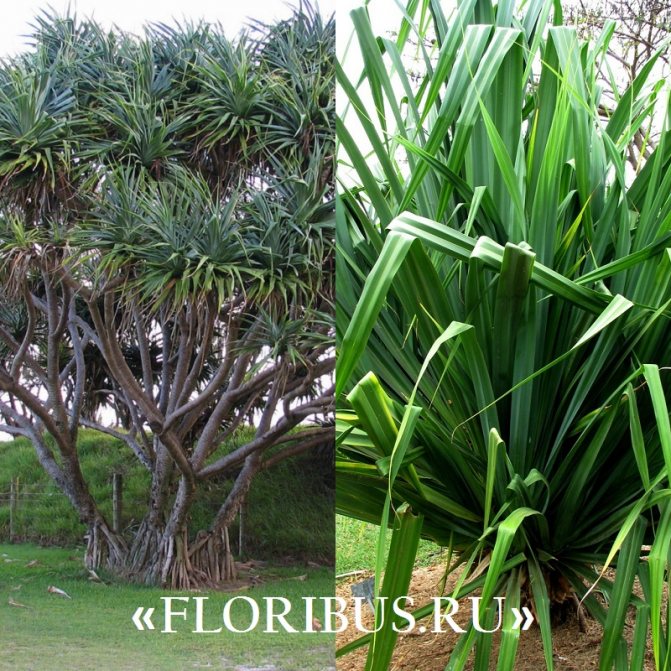

Can I keep in the house: signs and superstitions
Pandanus can often be found in offices and conservatories.
Many do not want to grow it at home because of superstitions, such as the following:
- a spiral palm tree absorbs the positive energy of a person like an energy vampire and fills the home with powerful heavy energy, which makes the inhabitants of the house aggressive and angry;
- pandanus causes insomnia, so it should not be placed in the bedroom.
Pandanus is thought to be a mental stimulant, which is why it is recommended to be placed in offices and other spacious work spaces.
Important! Pets and small children should not be used to grow the helix palm tree as they can injure themselves on the sharp thorns of the plant.
Care rules
As mentioned above, the impressive size and sharp "armor" do not scare away lovers of unpretentious plants. Ease of care and pronounced decorativeness come to the fore.
Temperature and lighting
Without exception, all species of pandanus are photophilous, but this does not mean that they can be placed in direct sunlight. Diffused light will be much more useful! It is worth noting that homemade pandanus grows well even in partial shade. But variegated forms, for example, Veitch's pandanus, retain their color only in the presence of natural stable lighting. Typically, large specimens are placed on the floor, and medium and small specimens are placed on shelves and cabinets.
It is difficult to move a pot with a weighty flower, but miniature specimens will not mind spending the summer on the balcony
It is important to remember that thermophilic pandanuses do not tolerate a strong drop in temperatures. The minimum comfortable temperature for them is 13 degrees, lower ones exclude watering and can harm the plant, despite its unpretentiousness
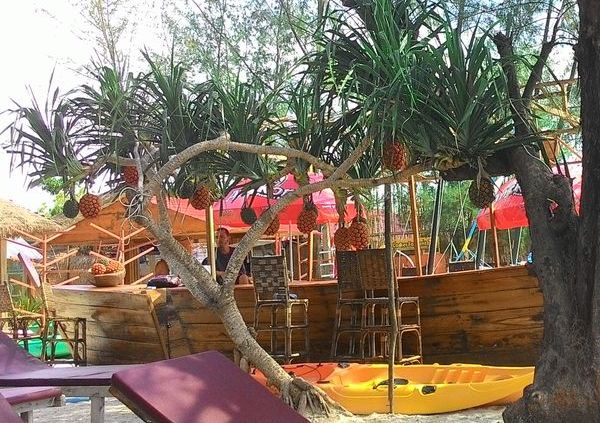

photo of the author
Watering and moisture
For a pandanus flower, care involves regular watering. He is patient with the lack of moisture, but, like most plants, he does not tolerate overflow. During the growing period, subject to a warm content, watering can be moderate or abundant, depending on the condition of the topsoil. When growth stops, they try to reduce watering, as the need for water decreases. This exotic does not impose any requirements on air humidity: it can grow successfully even at minimal rates.
Important! When watering, do not pour water into the swirling spirals of the leaves. There moisture lingers, and can provoke rotting of the outer part. 8 questions about watering.
Fertilizers and feeding
The pandanus does not need any special feeding.He may well be content with periodic fertilization with complex mixtures for decorative deciduous trees, with a predominance of nitrogen. Whereas an excess of trace elements is likely to be harmful!
Reproduction and transplantation
The pandanus plant, which requires periodic transplanting, often grows to impressive sizes even in indoor conditions. If the supporting roots are not sufficiently developed, it can tilt under the weight of the crown. Therefore, when choosing a pot, you should give preference to sustainable options. For convenience, you can place such a pot on a stand with wheels.
Pandanus grows slowly, so you won't need to repot it often. Annual transplantation is needed only for newly rooted cuttings, and then - as it grows.
Important! The mistake is to plant the plant deeply with deepening aerial roots, which are formed at the base of the trunk. When planting, they should remain outside, and to conserve moisture, they are wrapped in wet moss, or more often sprayed.
When preparing the substrate, you can limit yourself to several components: sand, or any other baking powder, peat and garden humus. The earthen mixture should be sufficiently loose and not "clogged", but breathable.
At home, pandanus lends itself best to propagation by cuttings, or daughter rosettes that form on the stem. They are cut off, allowed to dry slightly and rooted in water, after dusting the cut with charcoal or phytosporin. The cut of the cutting is immersed in water to a depth of no more than 1-2 cm. For successful rooting, a temperature of at least 20-25 degrees is important. Rooted cuttings can be planted in light soil, adding more nutrient soil as they grow.
You can root the cuttings immediately in the ground, deepening them slightly and placing them on a support in a greenhouse from a bag in a place protected from the sun. Watering should be careful, without waterlogging until roots appear.
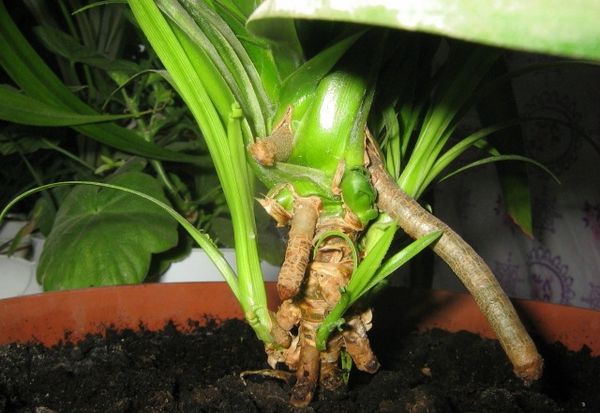

Pandanus benefit or harm
Palm hamedorea - home care
If at home it is almost impossible to see the flowering of exotic plants, then in nature the plant blooms very beautifully. The tree during this period is decorated with spikelets of numerous small inflorescences. The flowers do not have perianths, but cover leaves.
The plant is unisexual. Therefore, male flowers appear on one shrub. They resemble elongated spikelets. On the female, the inflorescences are in the form of corn cobs. Exotic flowering is accompanied by a delicate pleasant fruity aroma.
The fruit resembles a pineapple. As it grows, it becomes clear that the fruit has features and resembles pineapple only distantly.
It is difficult to collect fruits from compound fruits. They can be compared to very large corn kernels.
Residents of the Pacific Islands, Papua New Guinea cannot imagine their diet without pandanus fruits. Pandan fruit provides people with vitamins, gives a boost of vivacity, saturation. Fruits are boiled, cooked over a fire or eaten fresh. It is noteworthy that not only the fruits are edible in the plant, but also the lower parts of the foliage, inflorescences.
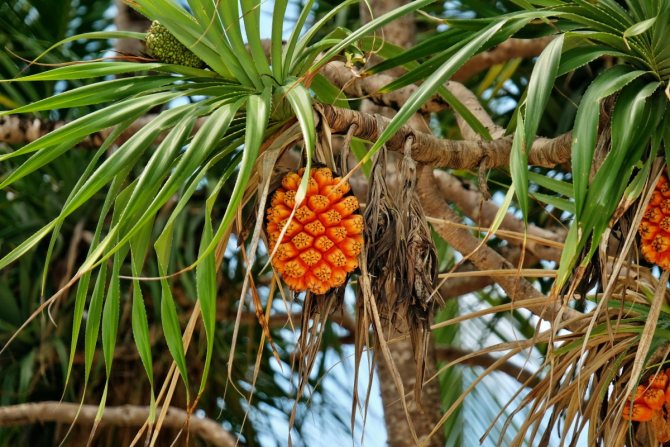

Pandan fruit
Some tourists believe that the pandanus is poisonous. This is not true. The fruit is edible and incapable of causing harm. On the contrary, the pandanus is useful.
For example:
- Seed oil tones the body, benefits the nervous system.
- The oil is used to eliminate migraines and headaches.
- The leaves are suitable for healing wounds, abscesses, skin diseases.
- The gruel from the leaves helps in the treatment of infectious diseases such as leprosy (leprosy), etc.
Features of the
This plant belongs to the evergreen tree-like, therefore, in the wild, this culture can grow up to 15 meters, and sometimes reaches all 25 meters in height. Outwardly, the culture is very similar to a tropical plant: a palm tree or a liana. Aerial roots can form on it. After a while, they usually begin to sprout into the soil.
After a while, the pandan's tissues die and die at the bottom of the trunk, but it is still vertical, since the aerial roots, which have already grown into the ground, begin to gradually lignify and form a kind of support for the tree.
The leaves are like a sword: narrow, linear. They can be more than 10 cm wide, and their length reaches 4 m. The leaves grow in the form of a spiral in two rows on the tree. Another name for this culture is the spiral palm. After some time, as the tree grows, the leaves that are below gradually age and fall off, leaving scars at the points of attachment to the trunk.
Pandanus blooms, forming inflorescences in the form of a panicle. The flowers are usually small and yellow in color. Indoor pandanus rarely blooms.
The plant is considered unpretentious and does not require special attention to itself, therefore it is very often grown in greenhouses and conservatories. The pandanus is tolerant to moisture deficiency, as well as to dark growing areas. Only a young plant is recommended to grow at home, since adult overgrown crops require an appropriate room size.
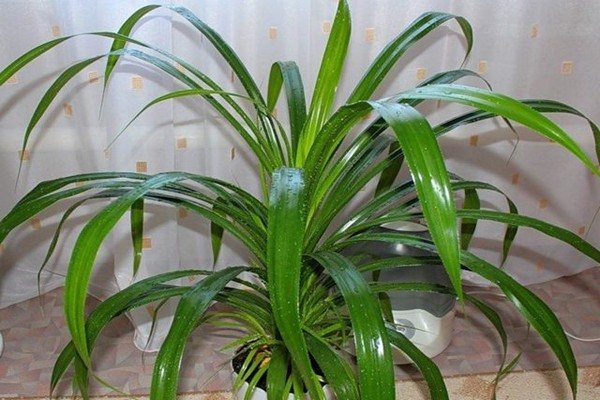

Possible growing problems - table
| Problem | Cause | Elimination methods |
| The appearance of a brown tint at the tips of the leaves |
|
|
| Yellowing of leaves |
|
|
| Loss of color intensity |
|
|
| Drying the leaves | Burn from direct sunlight. | It is better to rearrange the palm tree in a semi-shady place. |
Another way to reproduce
The species of Pandanus Sander and Veitch can be propagated vegetatively: by cuttings or rosettes-children formed at the base of the trunk. Parts of lateral shoots are cut into cuttings. These must be at least 20 cm long. The place of the cut is powdered with crushed coal and rooted in the nutrient mixture. The following composition can be used as a substrate: equal parts of peat and pure river sand. It is deepened into the mixture by 3-4 cm. A good result is obtained if the plantings are covered and placed in a greenhouse with lower heating. The optimum temperature for rooting is +25 degrees. The roots will appear within 2 months. Care for the cuttings before rooting in the same way as for planting from seeds.
Another breeding method for Pandanus Sander and Veitch is by planting daughter rosettes with leaves. They appear in adult plants in the root zone. As soon as the rosette reaches 20 cm in diameter, it can be deposited in another container with the substrate. As a nutrient soil, mixtures based on peat or humus are used. Dry the outlet at room temperature for 24 hours before planting in it.
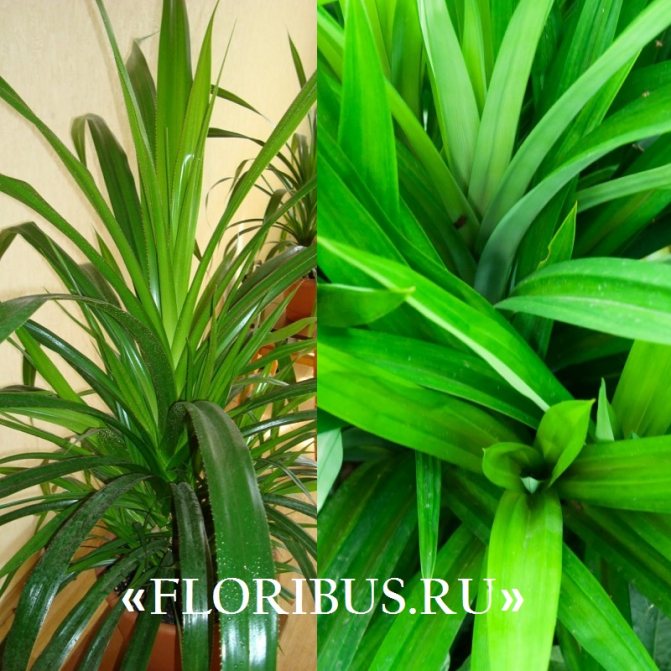

The planting material is buried in the soil so that at least 2 cm of the earth layer remains to the surface of the substrate. The planting is well tamped and watered with warm melt water. You can place the container in a greenhouse or simply cover it with a transparent glass or polyethylene cap. When breeding with rosettes, it is important to monitor the optimal level of humidity. This will help the condensation accumulating on the surface of the film or glass.There should not be too much of it (in this case, you need to leave the plantings for ventilation without a cap for several hours) or not enough (urgently sprinkle with melted warm water or pour with a moderate amount of moisture). Rooting, subject to all conditions, occurs in about 1-2 months, after another 40-60 days, you can transplant the plant to a permanent place and take care of it like an adult.
